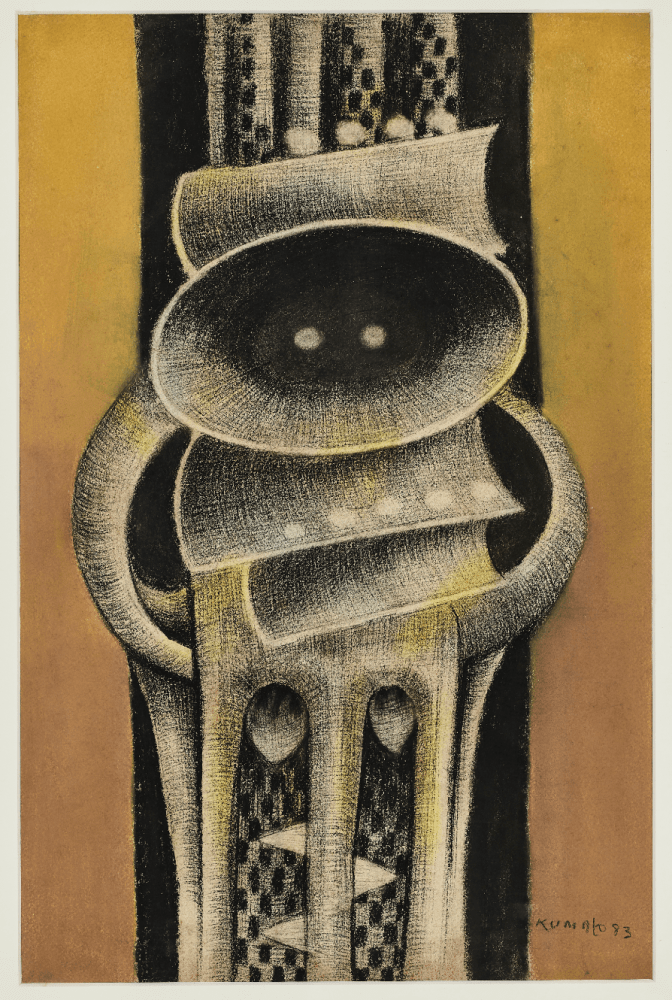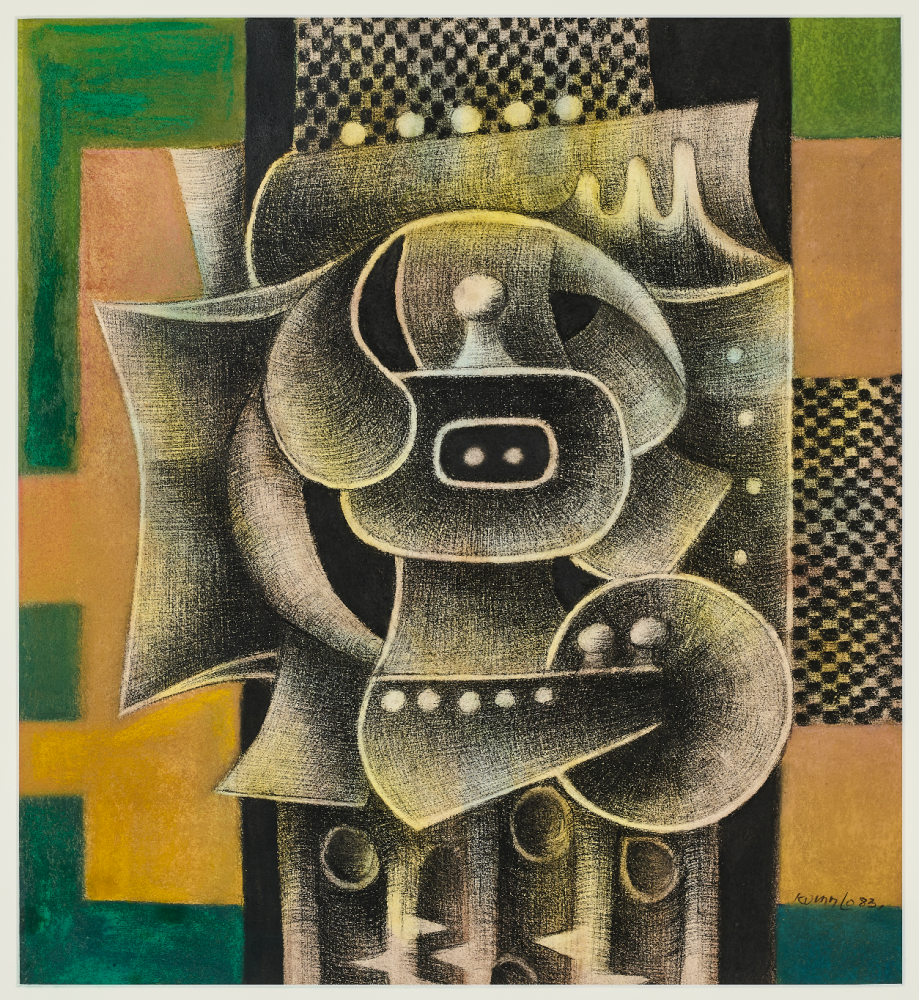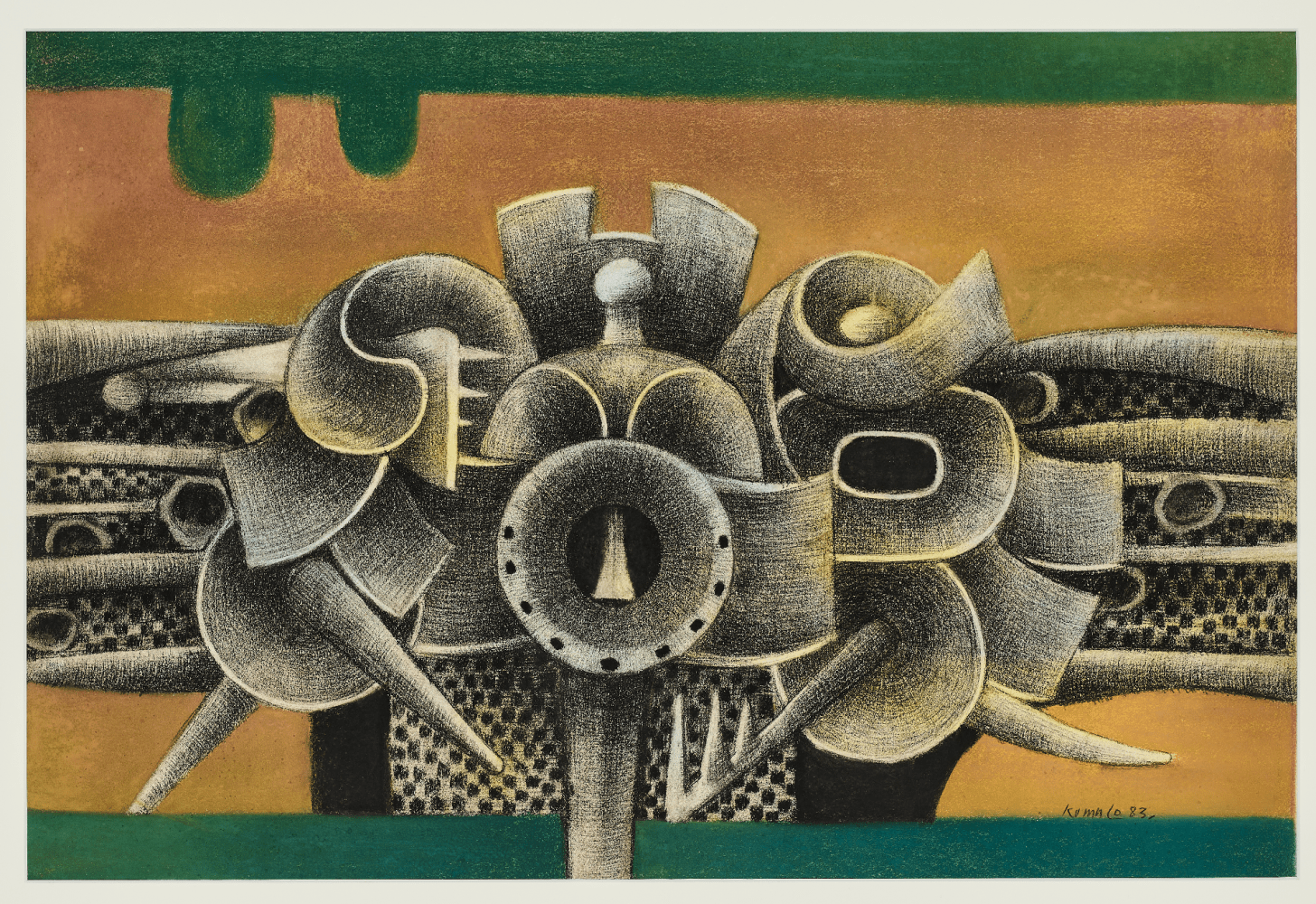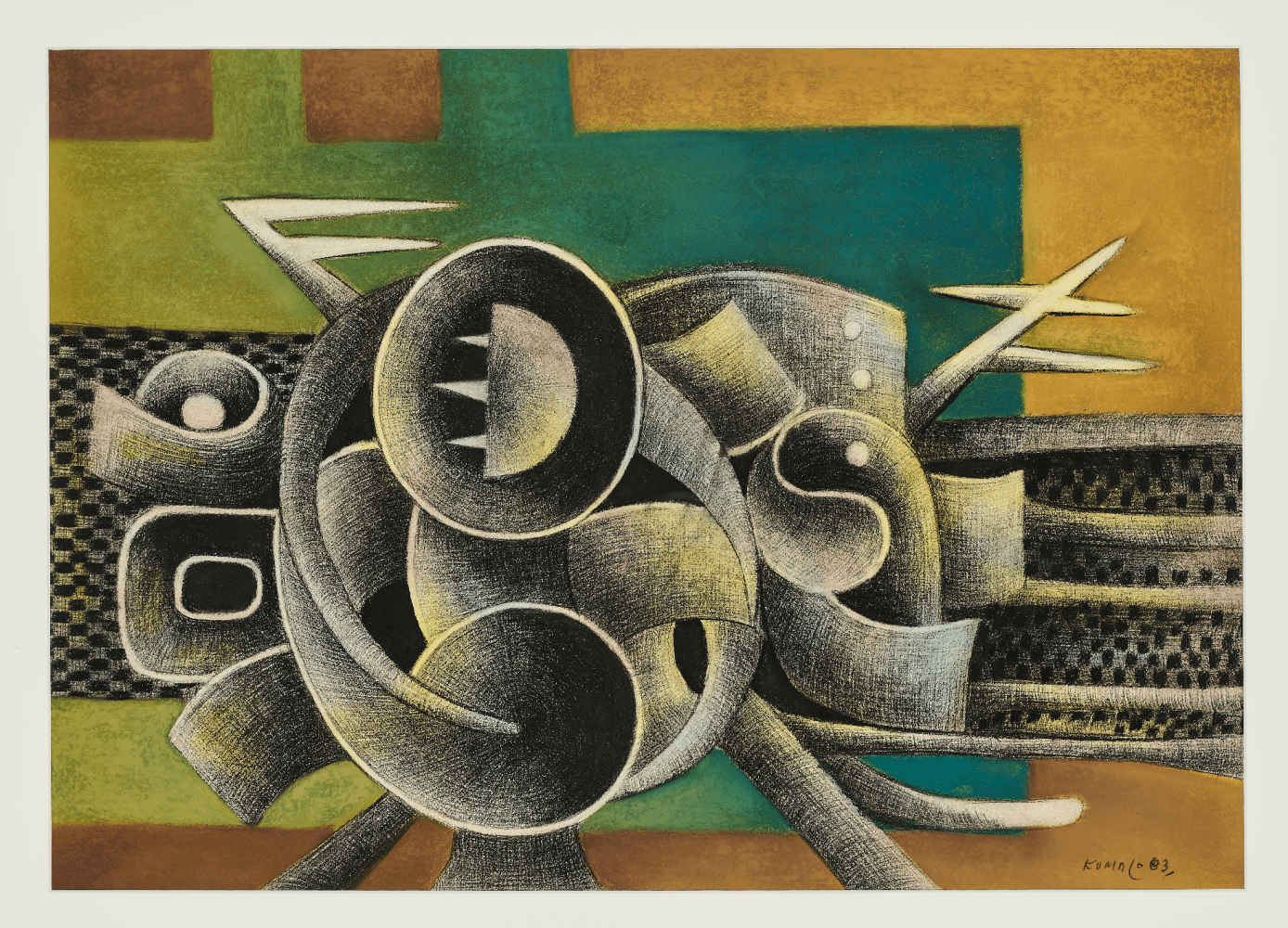Mapping Another Route — South African artists in a modern era
Goodman Gallery London
Head-Image
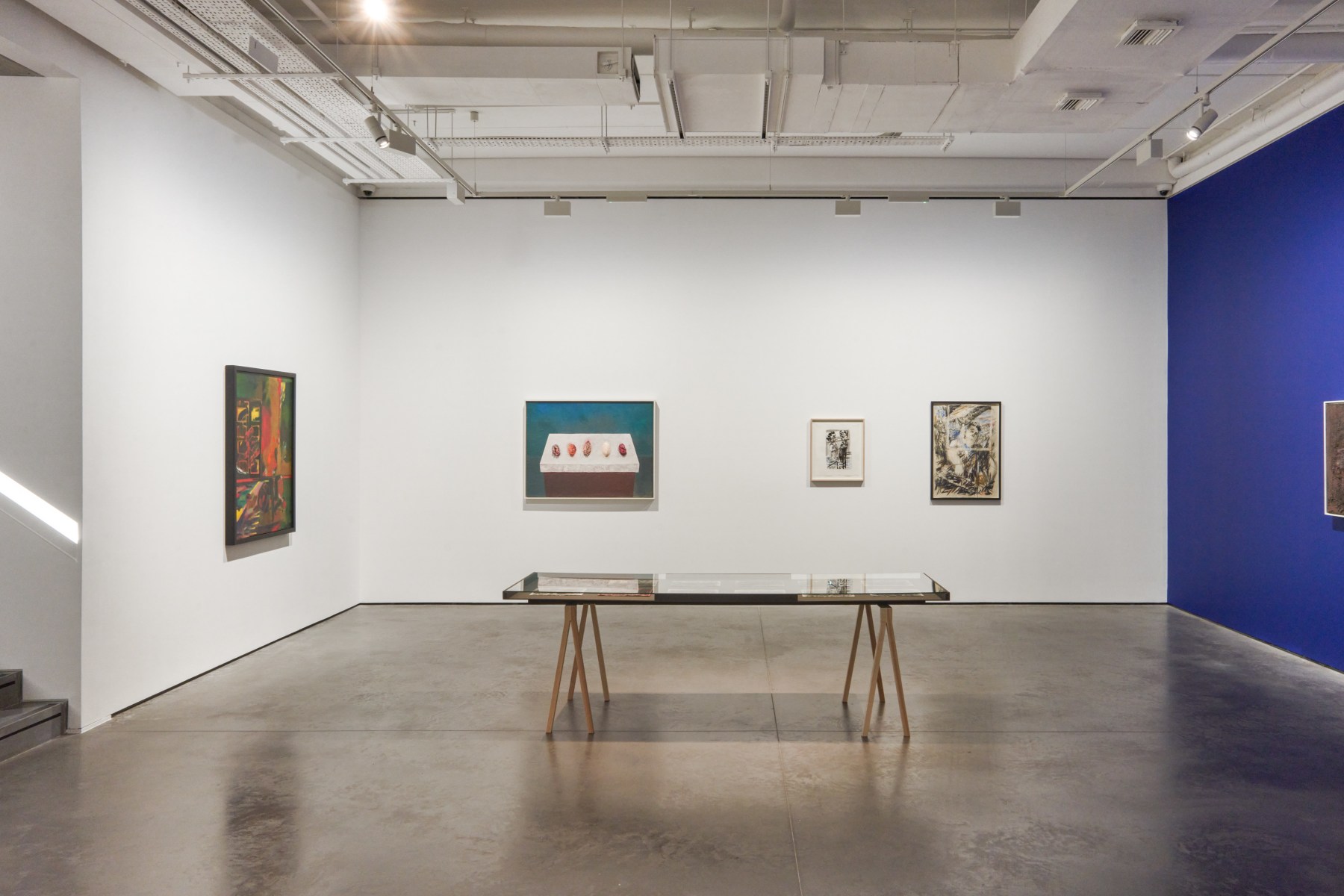
Goodman Gallery presents Mapping another Route - South African artists in a modern era, an exhibition featuring South African artists whose work reflects connections between art, politics and society in the latter half of the 20th century.
The exhibition marks the first of its kind at Goodman Gallery London, expanding on the 2006 exhibition Mapping the Route from the 60’s, held at Goodman Gallery Johannesburg, which included works by Sydney Kumalo, Dumile Feni, Mmapula Mmakgabo Helen Sebidi, David Koloane and Sam Nhlengethwa.
Mapping another Route seeks to hold space for conversations around the highly contested concept of the “modern era” while highlighting contributions of historically overlooked artists whose works manifest as hybrid evolutions of modern elements and urgent sociopolitical prompts.
The exhibition also expands on discussions sparked by influential exhibitions on African Art in the US and the UK from Art from Africa of Our Time (1961) staged by the Harmon Foundation in New York, which included Gerard Sekoto, and three decades later in the UK at The Whitechapel Gallery’s Seven Stories About Modern Art In Africa (1994) exhibition, co-curated by Koloane.
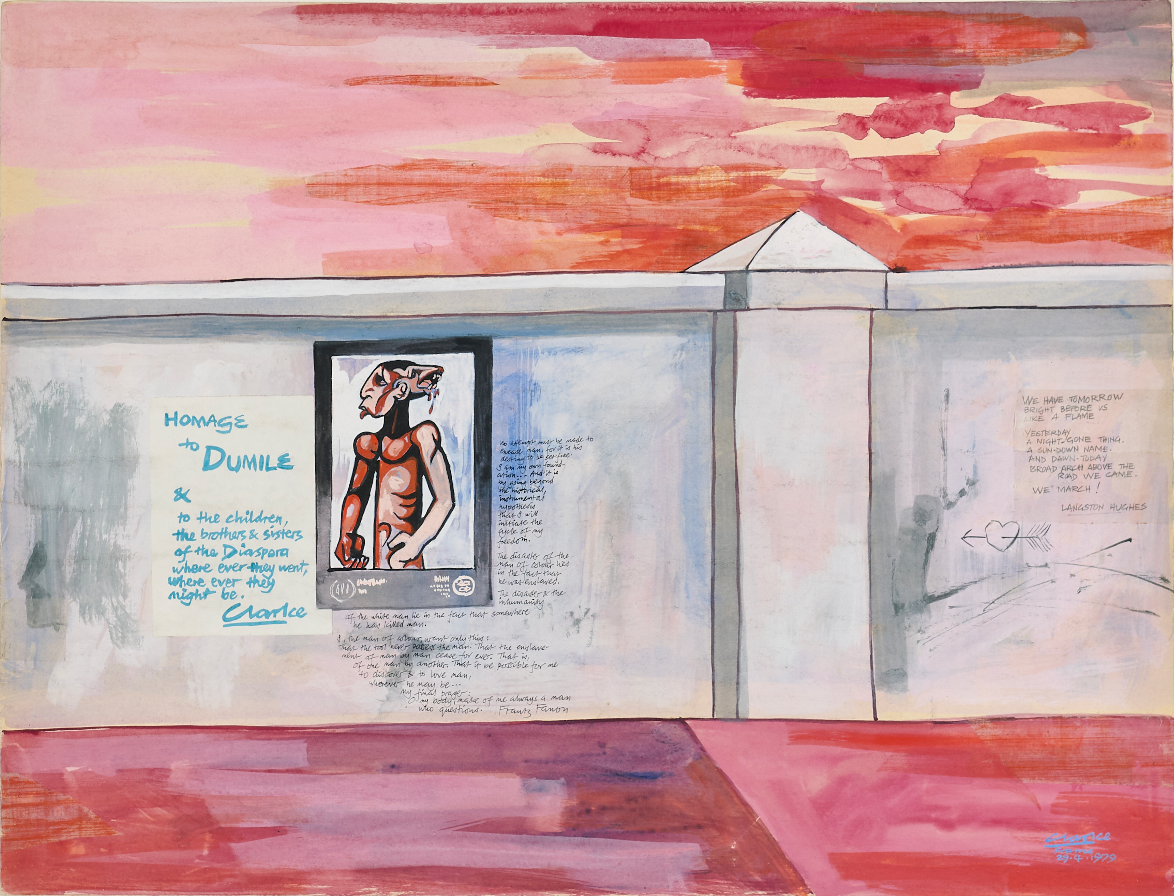
Peter Clarke
Homage to Dumile, 1979
Gouache and collage on paper
49 x 56 cm / 19.3 x 22 in.
Unique
Clarke was born in Simonstown in 1929, to a domestic worker mother and a dockworker father. He dropped out of high school and went to work on the docks, but word spread about his artistic talent, and he was offered work as a book illustrator, which led to a professional artistic and writing career. A watershed moment came when his family was forcibly removed from Simonstown to the ironically named inland ghetto of Ocean View as part of the enforcing of the apartheid Group Areas Act. Much of Clarke’s work and his subsequent political activism reflects on the dislocation of the experience.
Text by art critic James Sey
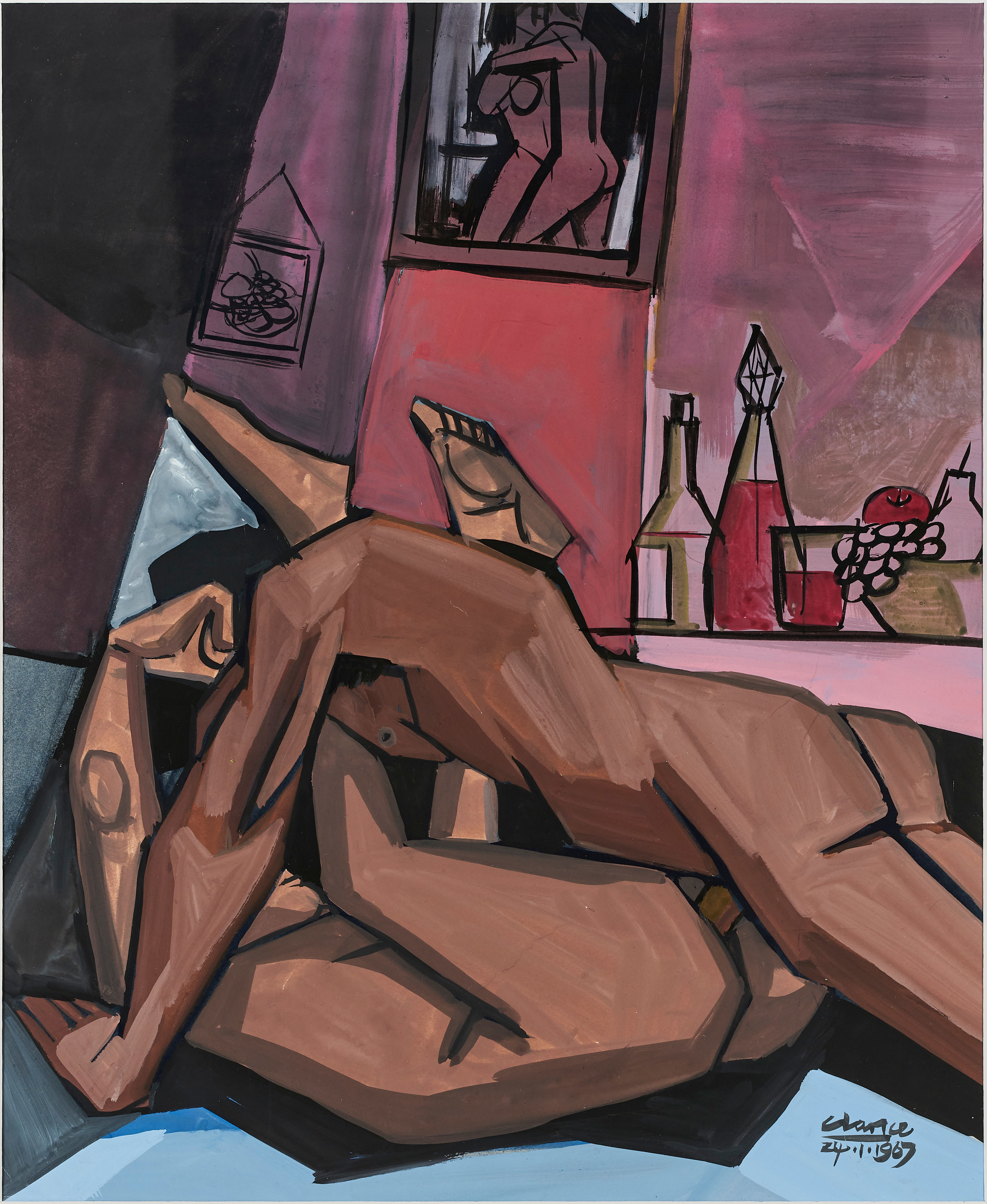
Peter Clarke
Lovers, 1967
Gouache on paper
99 x 84 cm / 39 x 33.1 in.
Peter Clarke’s artistic career is dominated by landscapes and character studies, often drawn from the fishing communities in the Cape where he grew up. Stylistically these demonstrate a gradually increasing degree of sophistication and individuation, despite his lack of a full formal training. In his later career this often translated into more obviously political works rather than the tranquil and bucolic studies of the 1950s, although these did not disappear from his oeuvre. Alongside this trajectory there was another, less prolific but no less powerful theme – eroticism. Many of his paintings, especially around the late 1960s and early 1970s, take sex, sometimes explicitly rendered as in this work, and erotic nudity as their themes. At one level Clarke is making a socio-political statement by producing work of this kind in a repressive and viciously conservative society, where book bannings were common and the depiction of eroticism criminalised. But also, there is an artist’s joy and exuberance in painting a scene such as this. The cubist influence on Clarke’s style is clearly evident in the angular depictions of the athletic and flexible lovers, as it is in the impossible angles of the interior and the facets of the bottles and glasses on the sideboard. The seductiveness of the bedroom scene is cleverly mirrored in the erotic painting on the wall, which shows perhaps an alternative position the lovers on the bed might get to eventually.
Text by art critic James Sey
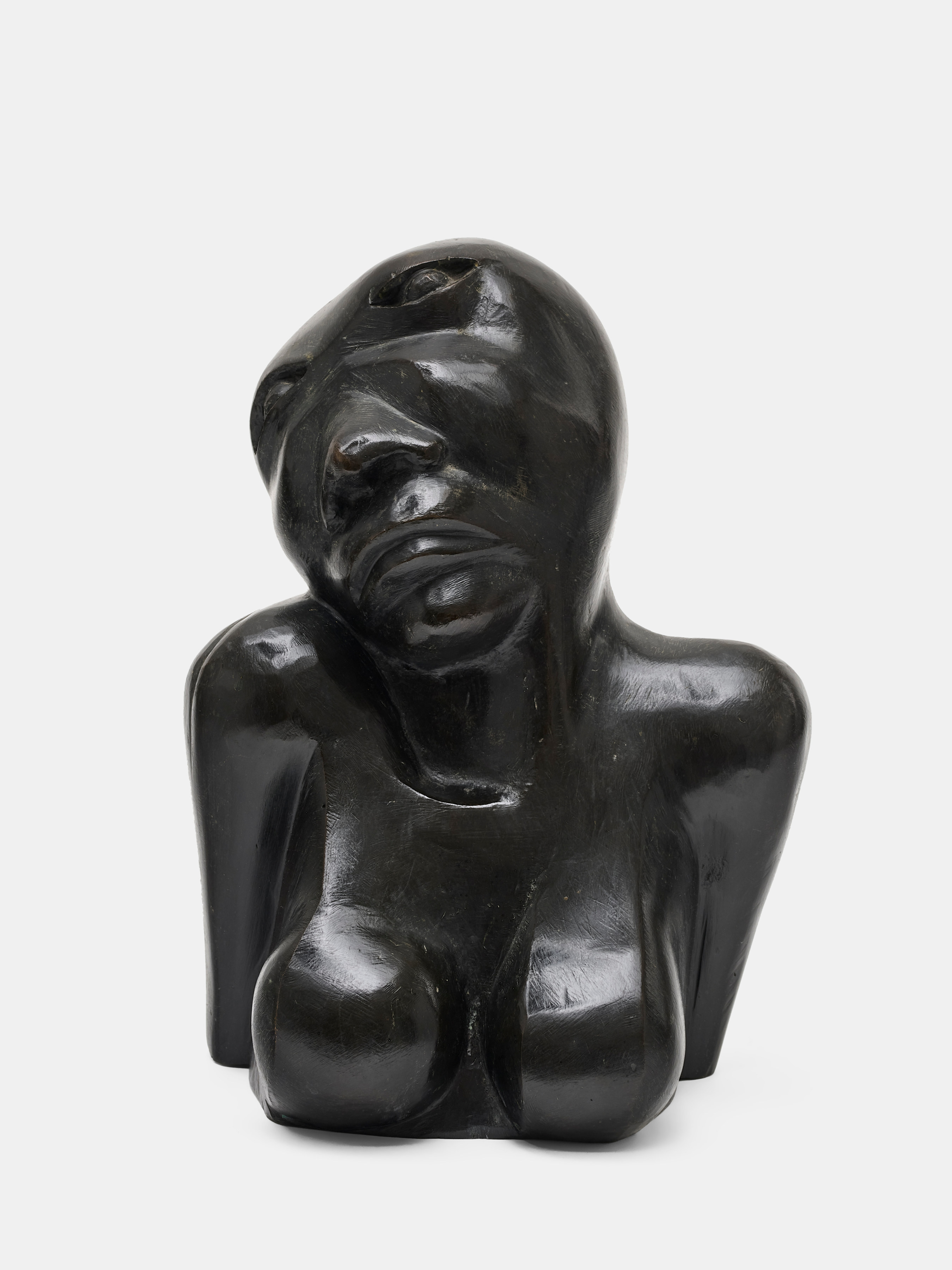
Dumile Feni
Anguished Woman, Circa 1967-1968
Bronze
29.5 x 41.5 cm / 11.6 x 16.3in.
Edition of 6
Dumile Feni—famously known as just Dumile—was born in Worcester, a small town outside of Cape Town, in 1942. He was raised in a Methodist family, by his father who was a policeman and his mother—a homemaker. However, he lost both parents—first his mother and then his father—before his teens. Though born Zwelidumile Mgxaji Mhlaba, the famed anti-apartheid artist would later enter the South African art stage as Dumile Feni—a gesture that would immortalize his late mother’s name, Bettie Nothemba Feni. Of course, one can’t say with certainty that the recurrent solicitude for maternal figures that pervades Dumile’s oeuvre emanates from this primary loss. However, the perpetual return, say, to the “mother and child” theme in the work, certainly isn’t motivated by a latent religious impulse to localize the Pieta. If anything, Dumile’s frequent portrayal of women, particularly in his pre-exile phase—he left South Africa in 1968—often provides clues on the callous and indiscriminate violence of the apartheid regime. The 1960s typified the height of political repression. Anguished Woman (1967/68) is a small but powerful bronze cast frontal torso of a female figure with a head plunged in between her shoulders. Her face delineates a deep sense of despondency as she stares into pitiless air, while her arms seem to be pulled to the back as if cuffed.
Here Dumile also slightly traps the viewer. By way of capturing her pain and pathos, the viewer isn’t just privy to the invisible presence of a culpable hand (placed at the back of the sculpture) which has obviously stripped this woman of her humanity and dignity. Gazing down at her twisted visage and body, we also become embroiled in the narrative either as potential sympathizers or her sadistic collaborators. Anguished Woman doubly comments on the state brutality as it also puts pressure on the viewer’s assumed position.
Text by art critic Athi Mongezeleli Joja
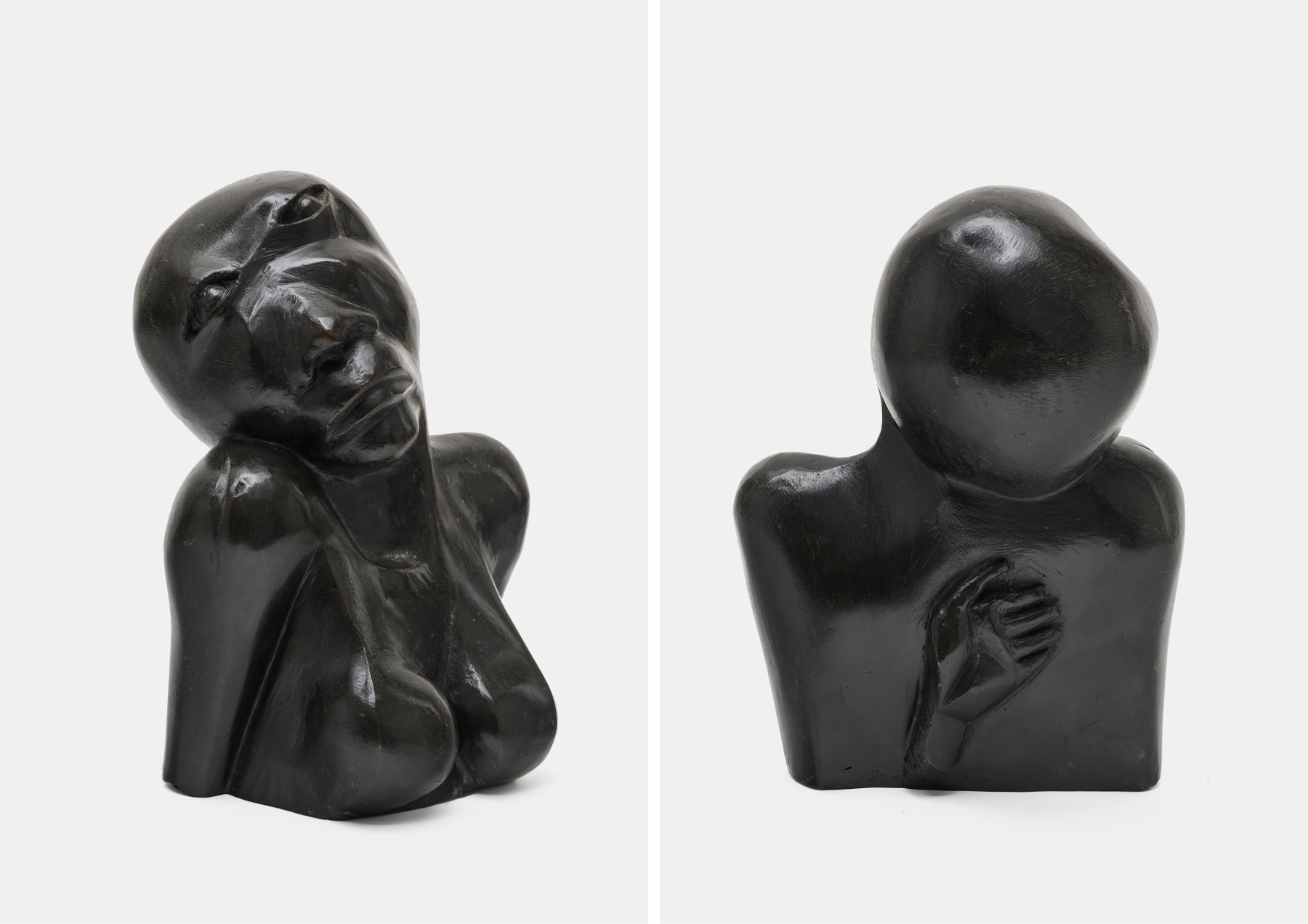
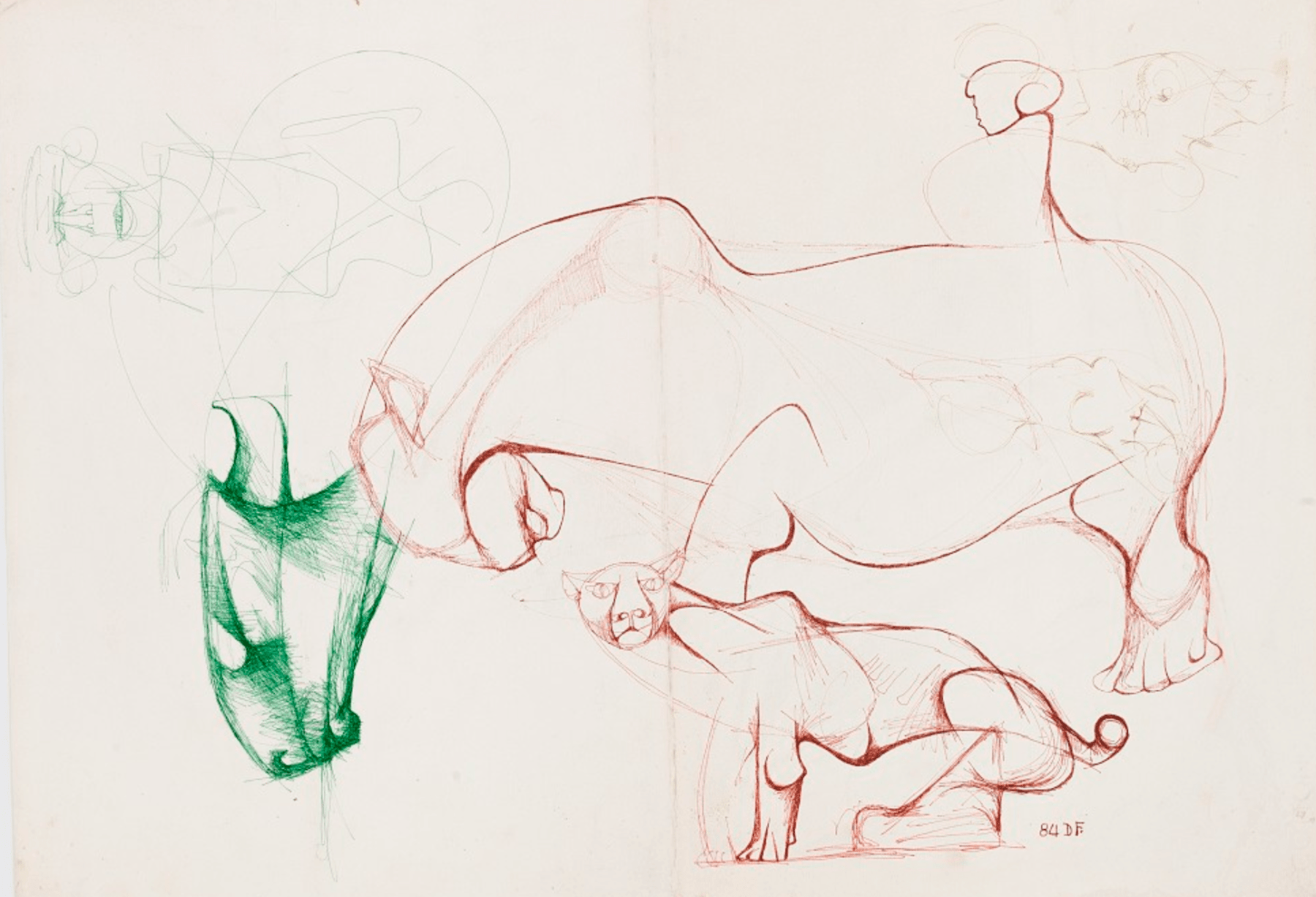
Dumile Feni
Untitled #28 (Double sided drawing, green and red ink sketches), 1984
Ink on paper
50 x 70 cm / 19.7 x 27.6 in.
Domestic animal forms are generic and pervasive motifs in Dumile Feni’s oeuvre. Cows, donkeys, horses, dogs, and cats all become metaphors for a fraught social reality, and better still, metonyms for an African-centred visual ecology. Like his contemporaries Sydney Kumalo and Ezrom Legae, this fascination with domestic animals was susceptible to multiple representations that spoke to the complex socio-political realities of apartheid South Africa. Besides that, this untitled study also epitomises Dumile’s later and cultivated development of his linework. Much of the work by Dumile Feni that is out there is generally “unfinished.” It is an oeuvre largely constituted of sketches, studies, and other forms of preparatory delineations. While at first, we might see this idiosyncratic practice as a mere outcome of the artist’s unfortunate life circumstances—exile, homelessness, penury, fragile health and so on—on another level, this fragmentary visual repertoire goes beyond being a mere sign of destitution and becomes a new gateway to understanding the artist’s mode of approach. But such a reading requires a certain jigsaw puzzle-approach to the artist’s practice; one that invites a more dynamic and generative viewership. That this drawing, for example, is rendered in two different ink hues on the same paper—green and red—possibly at different times, at first lends itself to be construed as an index of the financial situation but upon further analysis, this repetition and return is suggestive of Dumile’s latent archeological and inquisitive nature. Such intellectual proclivity is rarely afforded visual artists, let alone black ones.
Text by art critic Athi Mongezeleli Joja
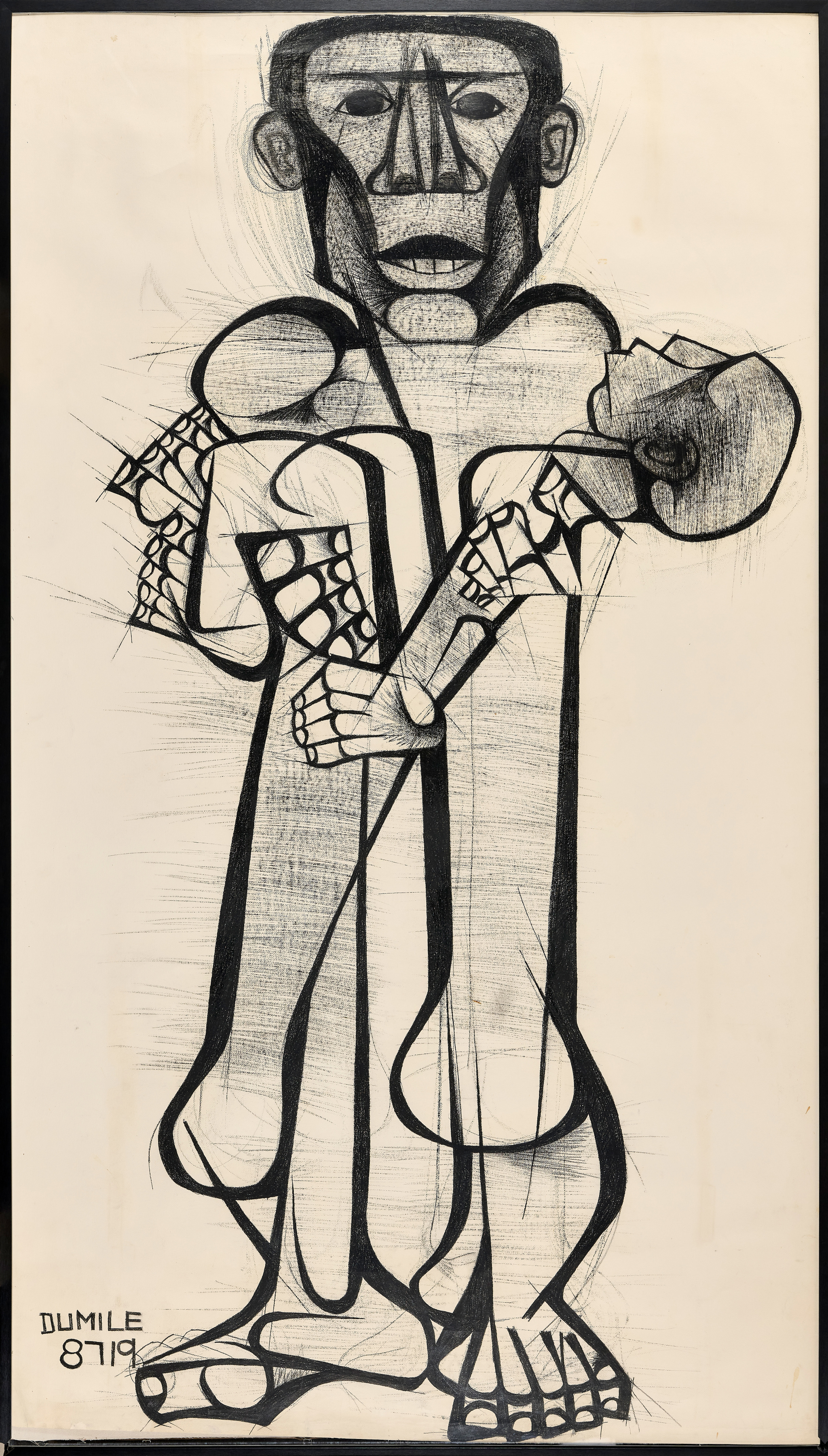
Dumile Feni
Hector Pieterson, 1987
Pen, ink and wash on paper
226 x 127.4 cm / 89 x 50.2 in.
Dumile Feni was a South African visual artist and anti-apartheid activist with African National Congress (ANC) affiliations. Often these two associations, i.e., art and politics, seem to be at odds with each other in the artist’s work. Why? This is partly because Dumile’s work never tows any expected propagandistic partisan lines or reduces itself to typical conventions of resistance art. Of course, it goes without saying his aesthetic sensibilities were largely predicated on speaking to and about the quotidian in politicized undertones. In other words, Dumile saw in the everyday the inescapability of the political in the everyday, while simultaneously glimpsing in the political, the pervasively common realities of a life lived under social duress. While the world saw in Hector Pieterson’s lifeless body, the shame and despotism of apartheid brutality that annihilated children of school going age, Dumile seems to have seen something else. Instead of focusing on the dead, he placed his visual emphasis on the living, in particular, the strong body of the other teenage boy, Mbuyisa Makhubu, carrying Pieterson’s body. Dumile not only enlarges the physicality of Makhubu, but he also typically manipulates the work’s date—that is, 1978 to 8719—to suggest a certain sense of continuity and futurity in struggle. You will ask: did the artist expect state racism go on indefinitely, and if so, why? Taken from Sam Nzima’s iconic photograph, pitched as if petitioning for global pity, Dumile re-interprets the picture to extract a temporality of fortitude and a narrative of resilience. In other words, rather than capitalizing on the narrative of sympathy alone that dominated the 1976 student protests, Dumile asks us to acknowledge the emergence of a new generation of freedom fighters.
Text by art critic Athi Mongezeleli Joja
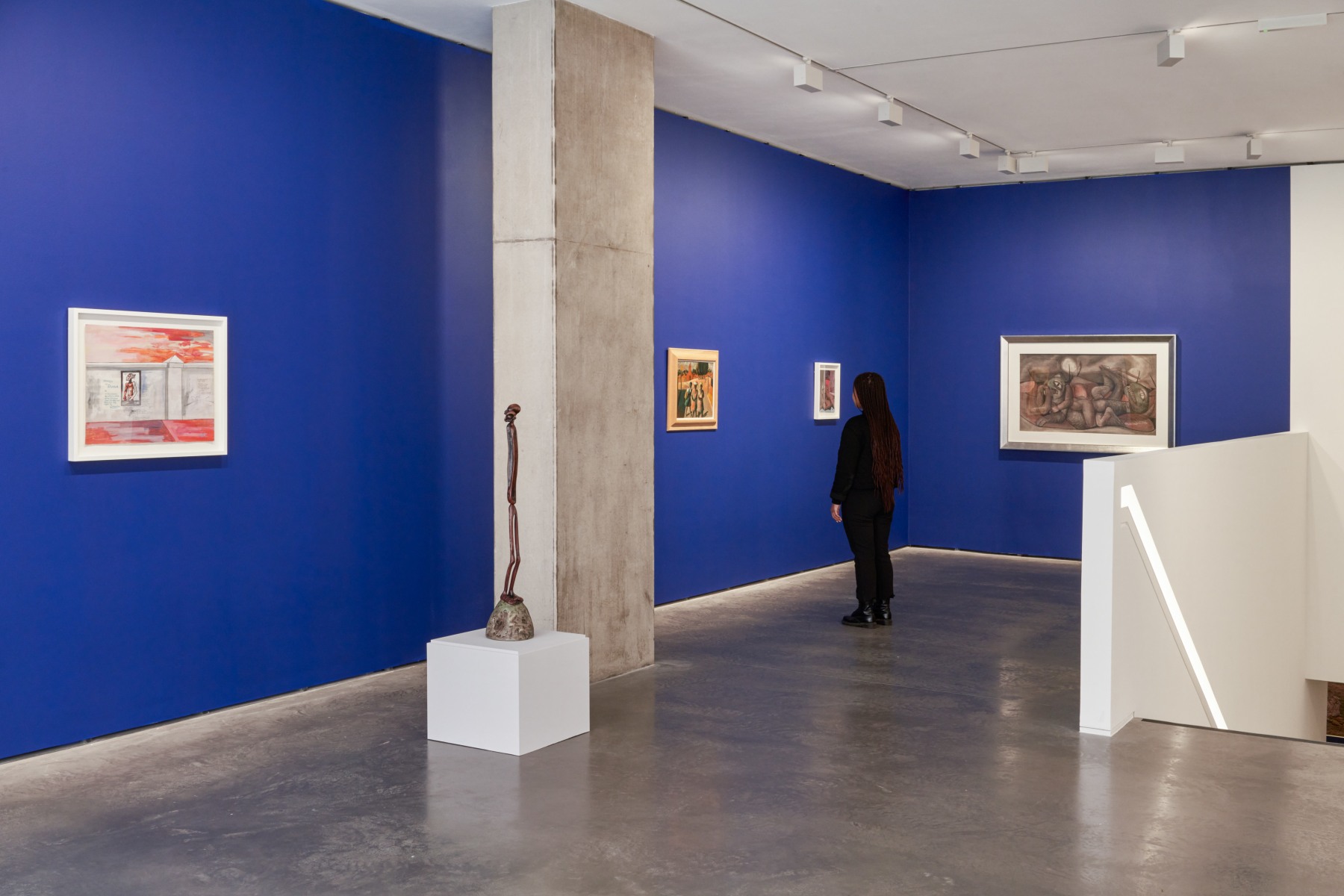
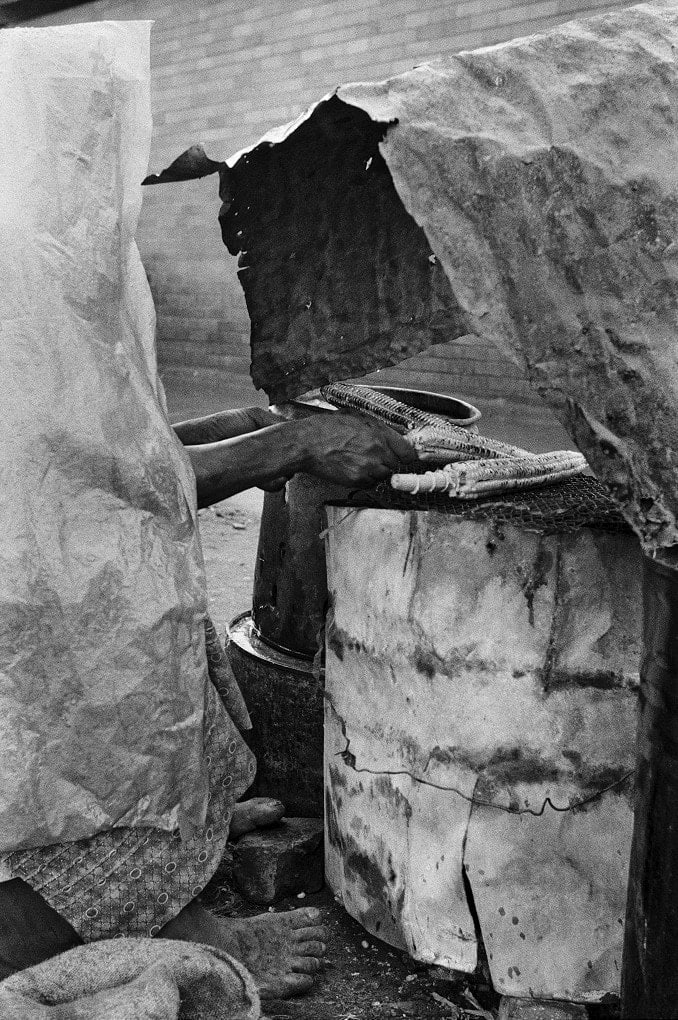
David Goldblatt
Roasting yellow mielies, West St, Johannesburg (3_3599), 1964
Silver gelatin hand print
18.9 x 12.8 cm / 7.4 x 5 in.
Roasting yellow mielies, West Street, Johannesburg (circa 1964) was taken a few years after Goldblatt closed his father's clothing shop in Randfontein. Goldblatt had decided to pursue photography full-time and was working on his seminal photographic essay, Some Afrikaners. Roasting yellow mielies, West Street, Johannesburg is reminiscent of Goldblatt's early explorations with the medium. At age 17, he would hitchhike from Randfontein into Johannesburg. He walked around the city until the next morning, talking to night watchmen and following his curiosity : "People would ask me what I was doing, and I would say, 'I'm' poeging. I'm walking around the city; I'm learning the city, and trying to take photographs." This process became the foundation of Goldblatt's practice.
Goldblatt sought to document an intimate dialogue between himself and his subject within a specific moment in time and place. The subtlety in this approach allowed his work to uncover difficult realities about a society pervasively penetrated by racial inequality, trauma and injustice. As such, we see an extraordinary documentation of the lived experience of his fellow South Africans.
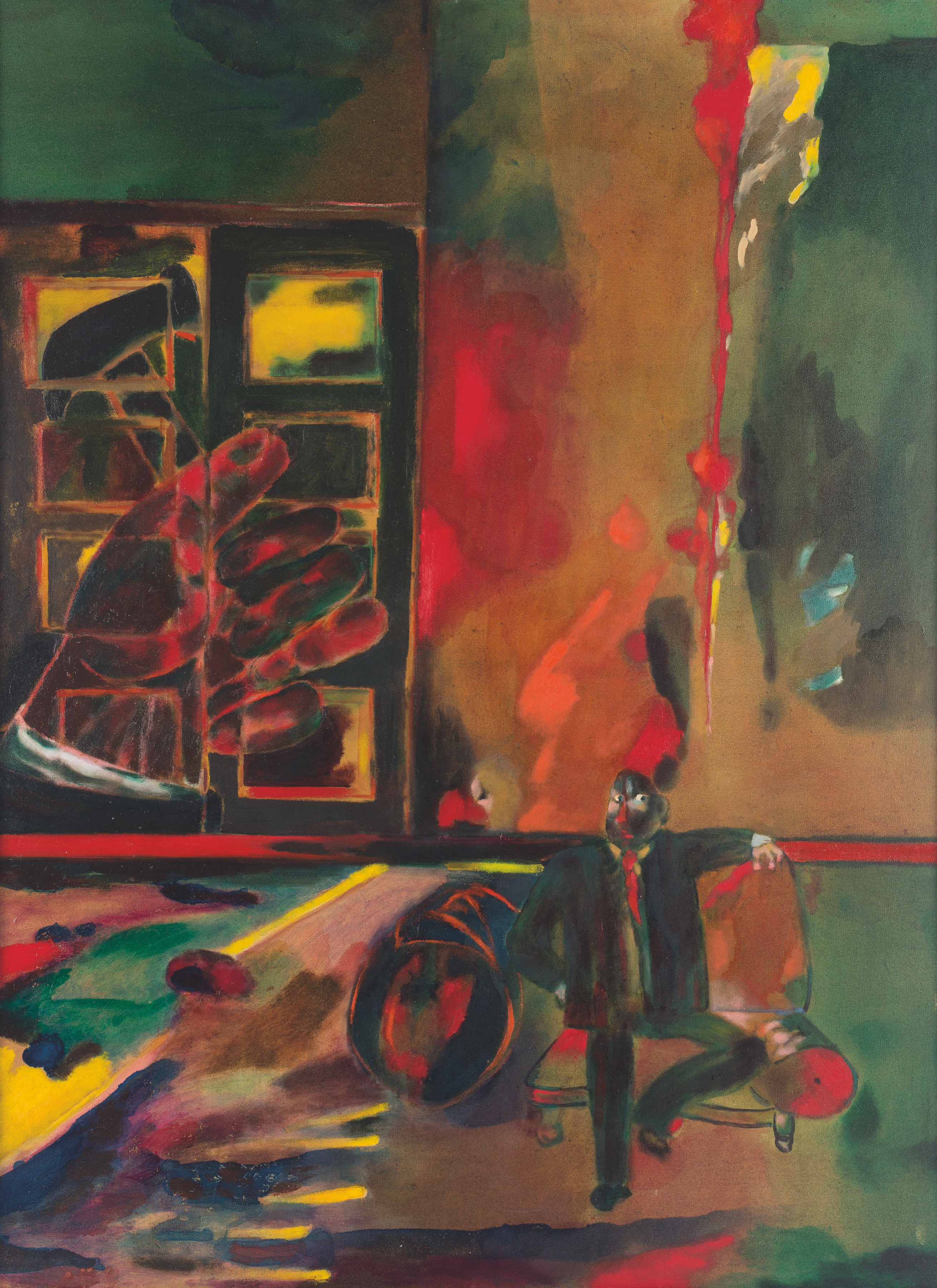
Robert Hodgins
The Tenth Circle, 1994/1995
Oil on canvas
120 x 90 cm / 47.2 x 35.4 in.
The sense of unease in a suited, but uncomfortably seated man, in the painting The Tenth Circle, 1994/95, illustrates very well the shift in power in South Africa after its first democratic elections in 1994. Hodgins keenly observed the lead up to the country’s Truth and Reconciliation Commission hearings, anticipating revelations of official criminality over five decades to be publicly acknowledged for the first time. The symbol of a hand with a hammer and the gathering gloom appearing like a storm brewing in the room highlight the rather defensive poise of the subject. Of the suit and red power tie in this work Hodgins wrote:
Is it a symbol of power or it symbolic of powerlessness without the suit? … without the suit, “I’m a little forked radish” to quote Shakespeare, but with the suit, I’m not a forked radish. I have a Position.
From the 1940s through to the early 1990s, South African artists of colour explored what it meant to carve out a black voice in relation to the apartheid context only to be met with racial prejudice and relegated to the periphery by the Western art canon. Each work operates as a time stamp on a temporal map, intertwined with the political turbulence and violence experienced in South Africa from pre to post apartheid years, including pieces by artists Ernest Mancoba, Dumile Feni and Louis Maqhubela who lived outside of the country for many years to escape oppressive circumstances.
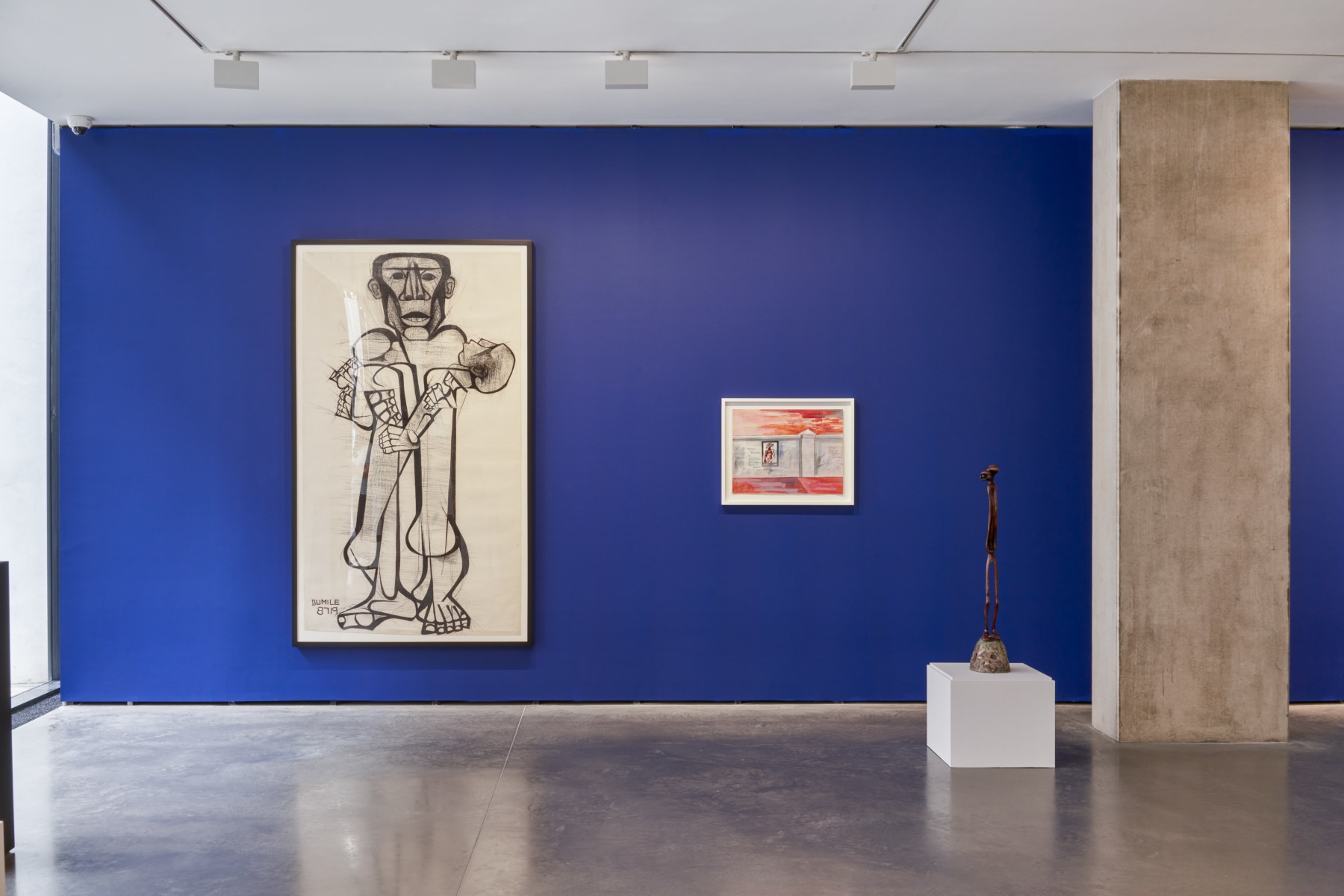
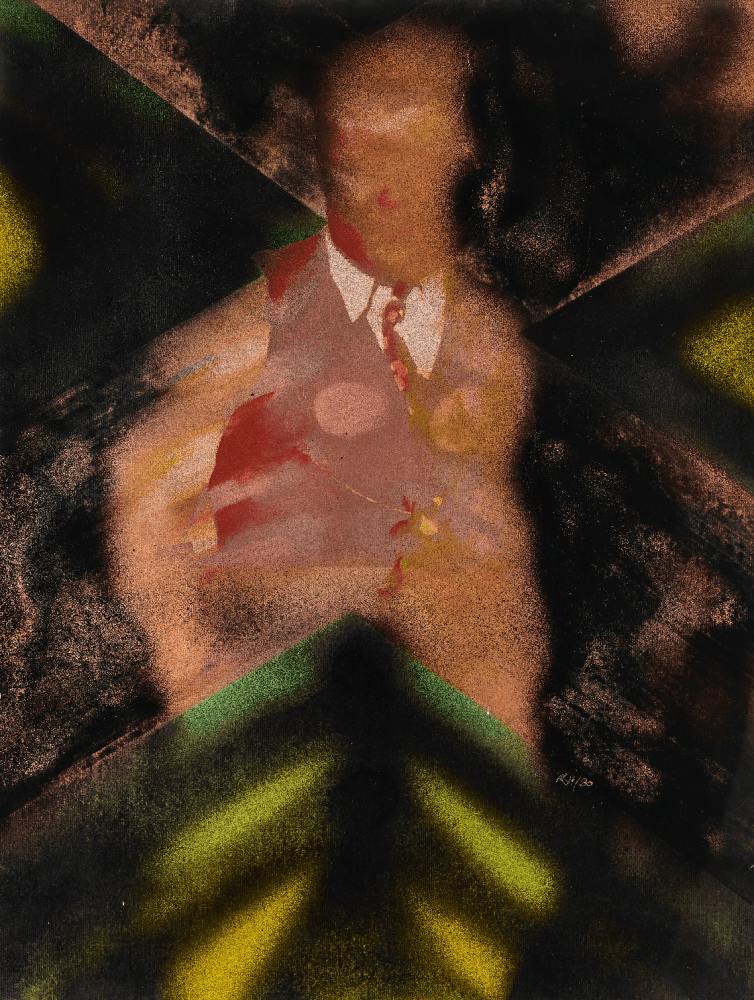
Robert Hodgins
Pretty Boy Floyd, 1980
Gouache and spraypaint over silkscreen on paper
65 x 50 cm / 25.6 x 19.7 in.
The image of American depression era bank robber Pretty Boy Floyd after his arrest in 1925, is a good example of Hodgins’ interest in examining the public following of criminals who cast themselves as underdogs. In this mixed media work painted in gouache and acrylic spray over a screen-print of Floyd, we see Hodgins use texture and over-painting to suggest the robber’s diminishment by arrest, fading from the news and fall from public admiration.
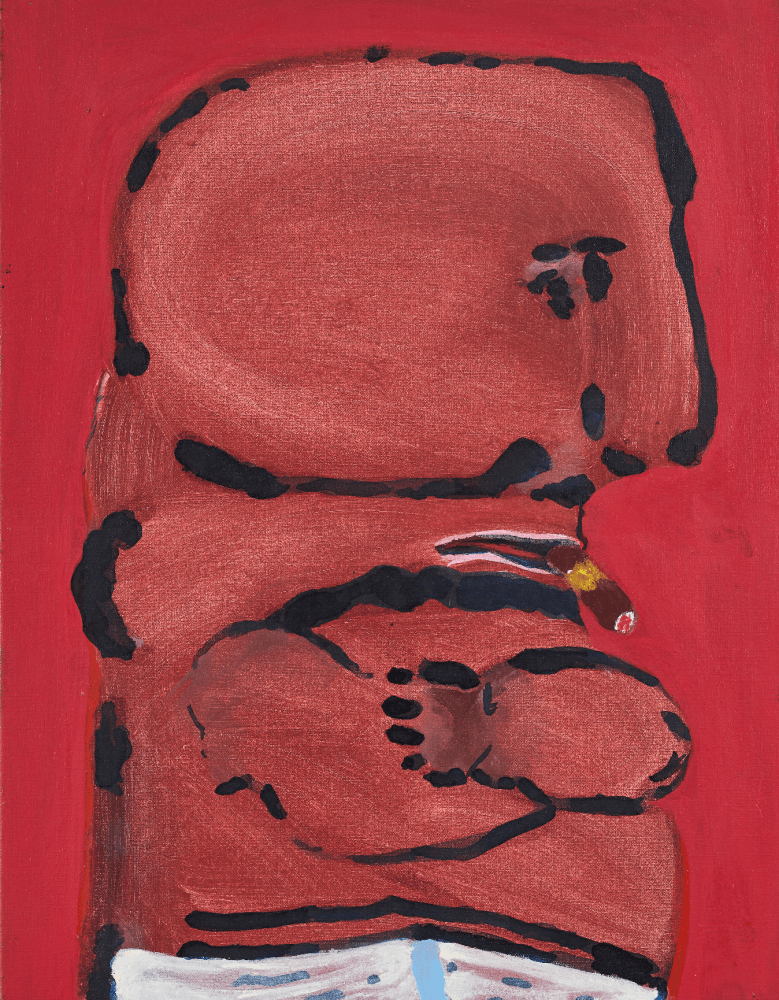
Robert Hodgins
Little Monster, 2002
Oil on canvas
45 x 35 cm / 17.7 x 13.8 in.
In Little Monster, outrage at children drafted into gangs and conflict around the world is tempered by a glimmer of grim humour in Hodgins’ treatment of “a little brat in a nappy smoking a cigar.” This work was prompted by his horror at press images of child soldiers pressed into serving in terrorist conflicts and young children corrupted in the drug trade in poverty-stricken South African communities. “I had to respond” he told this writer, “but it seemed unbearable. I needed to temper it with a little humour.”
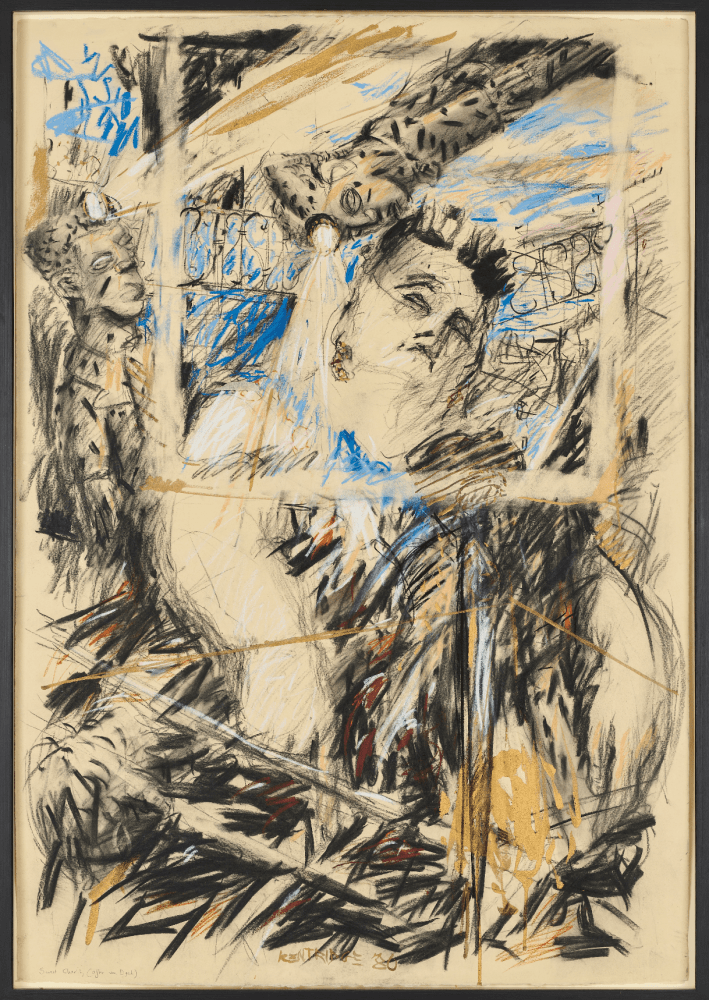
William Kentridge
Sweet Charity After Van Dyk, 1986
Charcoal and Pastel on paper
95.2 x 67.7 cm / 37.5 x 26.7 in.
Sweet Charity was made 4 years after Kentridge’s sojourn in Paris studying mime. It was also included in a Kentridge survey exhibition which travelled in Japan, 2009 – 2020. 1986 was a year of dramatic upheaval in South Africa. This drawing has a theatrical style, combining a central female figure and what appear to be carved African figures. The woman in the centre of the work is seemingly asleep, perhaps not conscious. She is spot lit from above and blanketed by objects. She seems unaware of where she is and what is around her.
Kentridge, using images of theatre and references to art history with his title, points to the life and times of his country in allegorical terms. Van Dyck was of Flemish (Dutch) family and became a court painter in England, known for being an innovative painter who introduced new intimacy and softer lines in his portraits.
Sweet Charity (after Van Dyck) must stimulate enquiry as to the references. Named for the stage production written by Neil Simon, (music and lyrics by Cy Coleman and Dorothy Fields), the stage work dealt with the life and challenges of a dancer for hire. It is in turn based on a Fellini film, Nights of Cabiria, 1957, the story of a prostitute living in hope of better things. The musical had its major Broadway revival in New York in 1986, directed by Bob Fosse. The tale is one of broken promises from men to the lead character, Charity; a “fallen woman,” who survives repeated attacks on her person and character yet remains ever hopeful. She can be seen as a metaphor for the long-suffering and patience of the deprived and oppressed peoples in apartheid South Africa
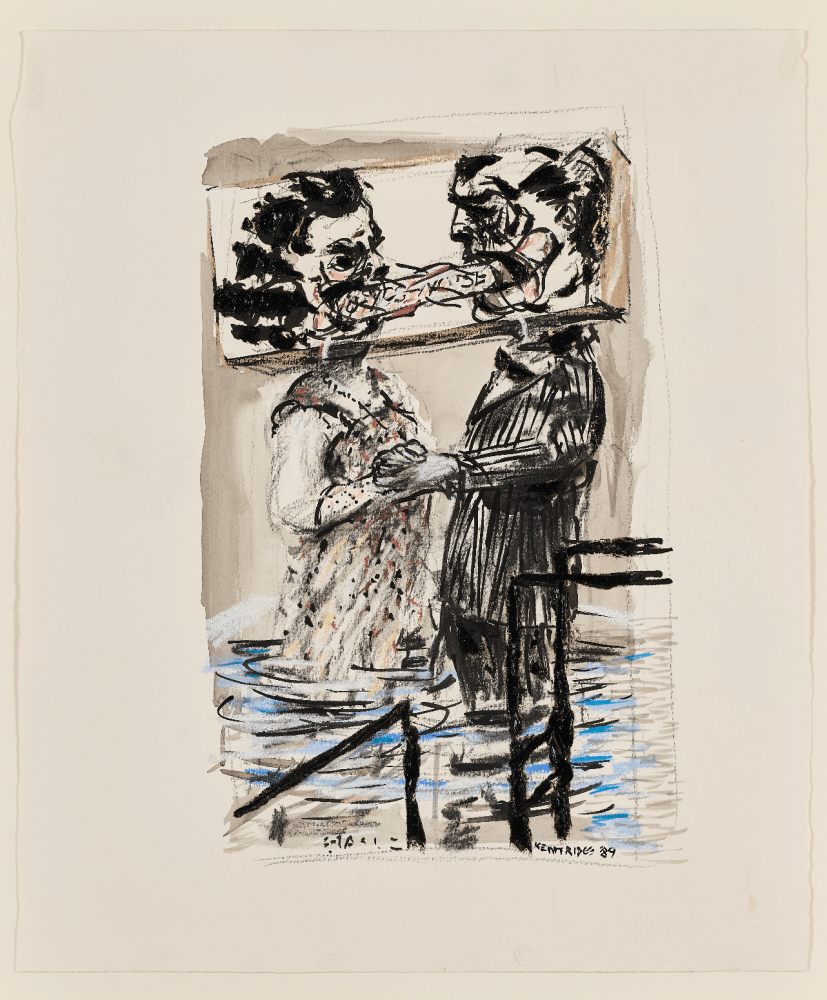
William Kentridge
The Battle Between Yes and No, 1989
Graphite, gouache and bitumen on paper
50.4 x 42 cm / 19.8 x 16.5 in.
The origin of the phrase ‘the battle between yes and no’ can be seen in one of Kentridge’s earliest films, Vetkoek / Fête Galante (1985) where a couple embrace in front of a large drawing of the words in blue chalk, ‘THE BATTLE BETWEEN’. Each figure wears a joint mask with the words ‘YES’ and ‘NO’ drawn in charcoal, followed by a frame with the word ‘NOISE’ written on a rectangular piece of paper and censoring the words ‘YES’ and ‘NO’.
The Battle Between Yes and No in this exhibition, is one of five drawings which Kentridge based on the idea of the film scene with these words. The Battle Between Yes and No portrays not only the difference in opinion of a couple in a domestic context, but also represents the social and political differences in white South Africa just prior to the release of Nelson Mandela and the unbanning of the African National Congress. The work was drawn in the same year that F.W de Klerk called for a ‘Yes/No’ referendum in October 1989 – ‘Yes’ for social and political reform or ‘No’ to this transformation. For the first time during apartheid-rule, the whites-only electorate called for a resounding ‘Yes’.
Kentridge also featured the subject in a large-scale colour silkscreen print (148.6 x 96.5 cm) in 1989. The link below is to the earlier film.
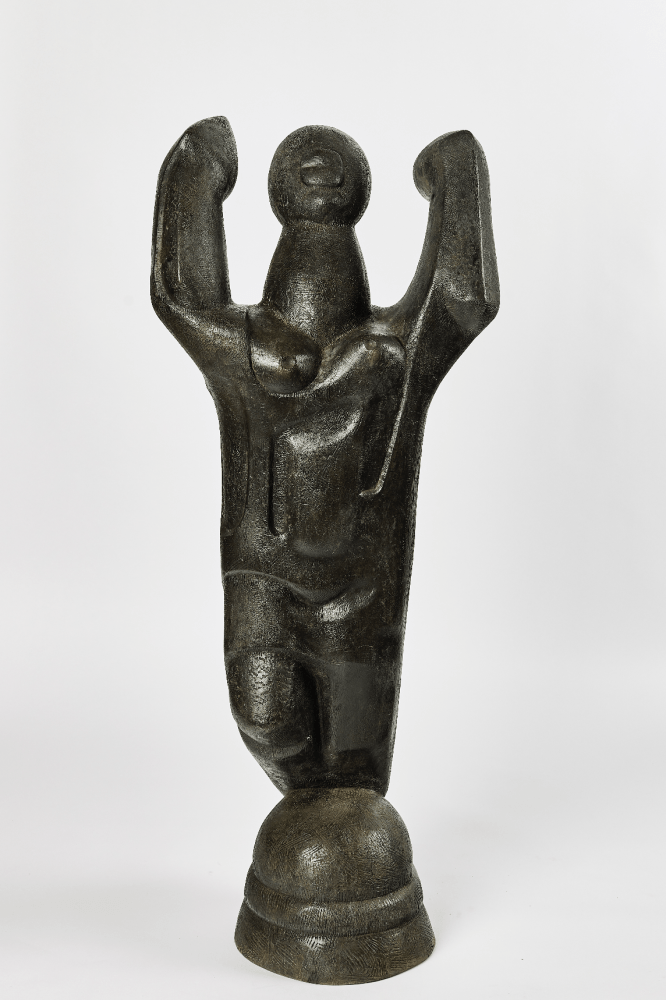
Sydney Kumalo
Anguished Angel, 1973
Bronze
96 x 38 x 33.5 cm / 37.8 x 15 x 13.2 in.
Edition of 5
Sydney Kumalo was born in Sophiatown, a melting pot district of Johannesburg at the time, where a vibrant integrated community thrived before apartheid laws enacted after 1948. His family was among those later forcibly removed from Sophiatown to Soweto. His talent saw him become a renowned and respected artist – painter, draughtsman, also often nicknamed the “father of Soweto sculpture.” Kumalo and fellow Soweto sculptor Ezrom Legae are the subjects of a new Catalogue Raisonné of their works in bronze.
Kumalo and Cecil Skotnes were colleagues at Polly Street Art Centre where they both met German/South African gallerist Egon Guenther who later represented them with peers in the Amadlozi Group. Kumalo wanted an African voice in the international discourse on new movements in art. He also exhibited through Guenther at the Grosvenor Gallery in London through the 1960’s and in the early 70’s moved to Goodman Gallery.
Kumalo’s travels in the UK and USA fostered his interest in modernist sculptors. He was impressed with the works of Henry Moore and Anthony Caro. He acknowledged the influence but also invoked the style of South African and West African carved forms. His works revealed an increasing interest in abstraction in drawn and sculpted figurative works, with both animal and human subjects. Kumalo exhibited at the Biennales of Venice (1965) and Sao Paulo (1968) and was a guest of the USSSALEP leadership exchange in New York in 1979. He visited and exhibited in Germany, at the Art Basel Fair and in a touring show in the USA with Goodman Gallery through the 1980’s. He died after a sudden brief illness in 1988, in Johannesburg.
The bronze Anguished Angel is a fine example of the great sculptor’s work. Its stance and support both reference the bible story of angels on the head of a pin. Its wings are diminished, folded, truncated, its arms thrown up. But this is an anguished protest, not signifying defeat or surrender. The artist produced other expressive sculptures also symbolising a call to God to liberate his people. The bronze was cast in the Renzo Vignali Foundry in Pretoria North in 1973. This edition 1/5 was exhibited at Goodman Gallery that year and sold to a private collector, its sole owner. Anguished Angel has been publicly exhibited only twice since 1973.
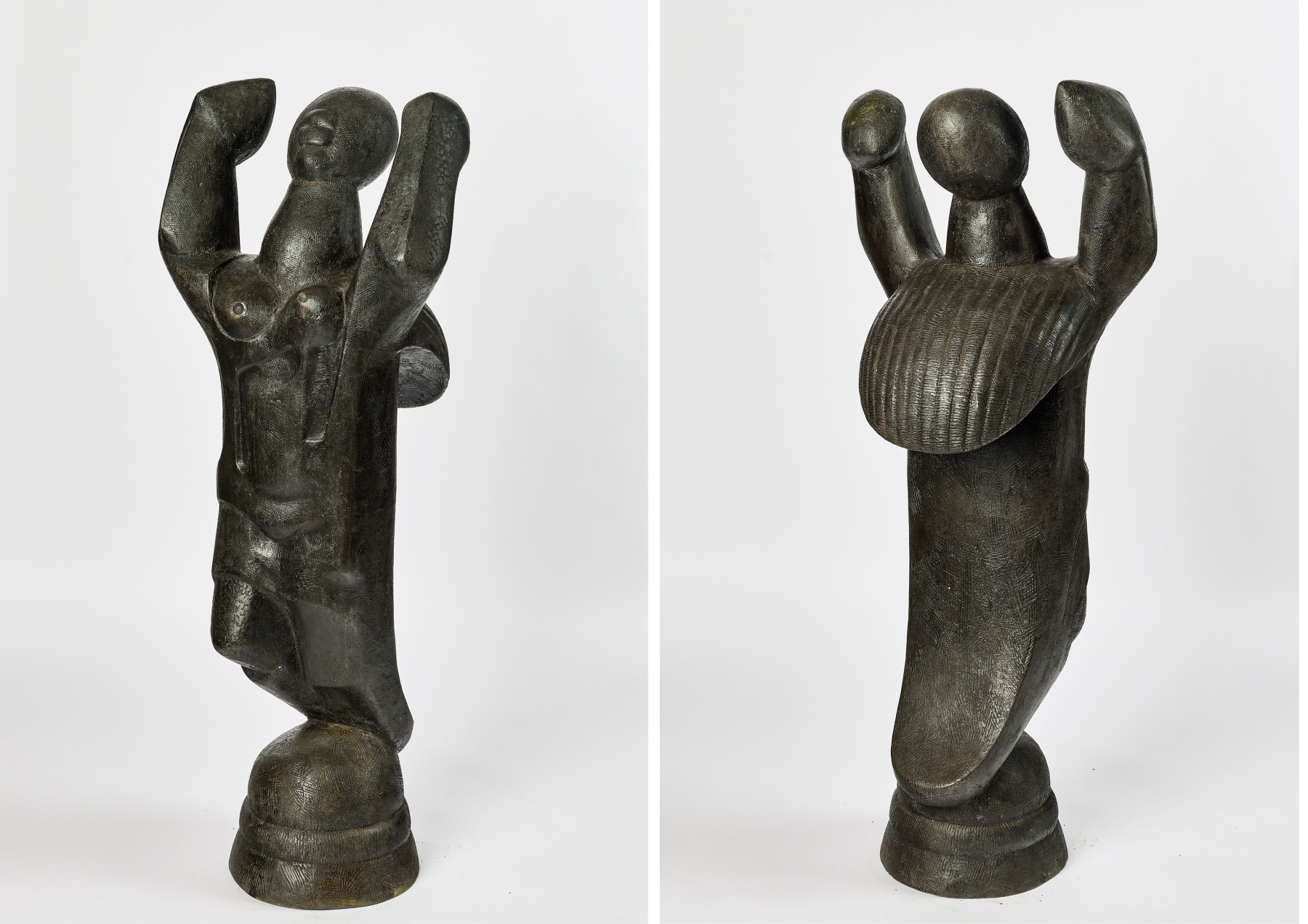
Many featured works make their UK debut however the exhibition comes at a moment in which we have started to see an increase in museum shows and collections recognising the contributions of these artists to the cultural landscape. The role of Koloane in particular, alongside Kagiso Patrick Mautloa and Sam Nhlengethwa and British philanthropist Robert Loder, in the founding of The Bag Factory artist studios in 1991 has been key not only for South African Art History but for establishing long-standing global connections via the Triangle Network which continue to foster artistic exchange today.
The series of four Kumalo drawings on this exhibition, Drawings for Wall Relief Sculpture: 1983, is typical of the artist’s study drawings, templates for what he would turn into three dimensions by carving terracotta clay, terrazzo, or plaster, before the making of a mould and first bronze casting. Kumalo drew most days in his studio, often exploring for himself the possibilities of mural sculpture, or untried figures in the round, and exploring colour.
Once a sculpture was completed, (cast or carved) he often made a second study drawing of the work to examine how his concept had been achieved. Such drawings served as design proposals for unique mural sculptures in stone, clay or occasionally painted plaster, as well as bronze editions in three dimensions.
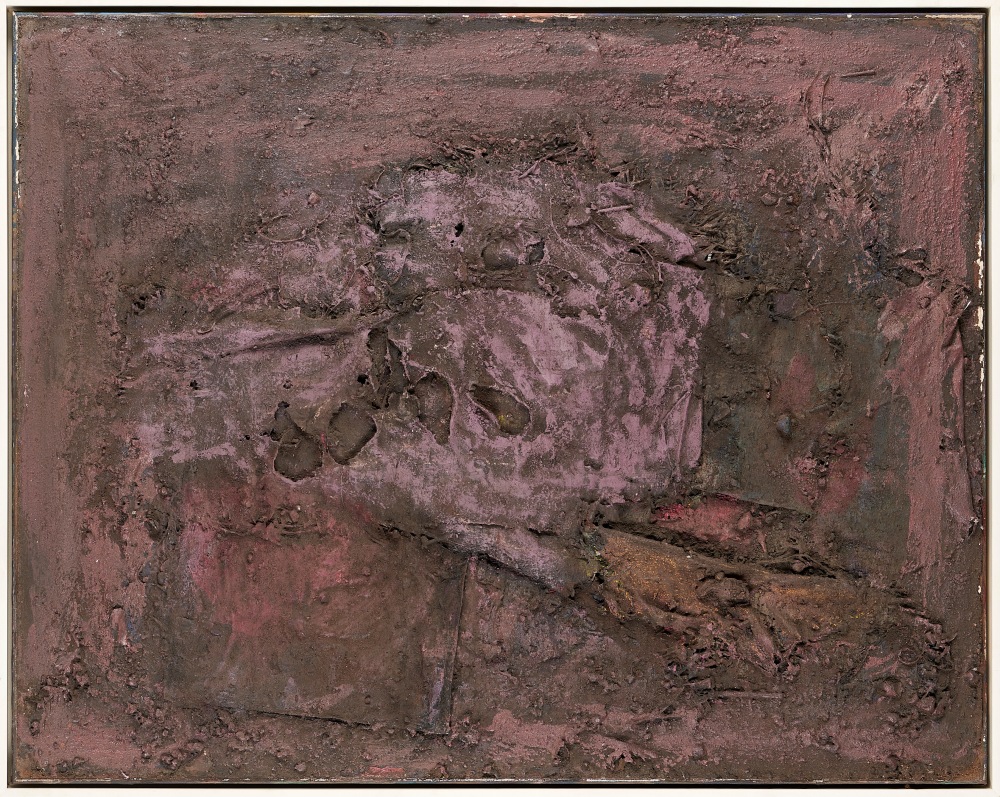
David Koloane
Remnants, 1990
Mixed media on canvas
96.4 x 76.4 cm / 38 x 30.1 in.
David Koloane (1938-2019) was born in Alexandra, Johannesburg. From 1983-1985, Koloane had a British Council scholarship and attended Birmingham Polytechnic. He later completed a diploma in Museum Studies at the University of London.
Throughout his life, Koloane worked as an artist, writer, curator, educator and mentor to fellow artists, creating art and encouraging art-making without the usual avenues of approach. From the late 70s onwards, Koloane co-founded and helped run several major arts spaces in Johannesburg, which were committed to ensuring safe spaces for Black artists to work and share ideas.
In 2019, the lziko South African National Gallery in Cape Town held a major survey of his work, titled A Resilient Visionary: Poetic Expressions of David Koloane. The exhibition later travelled to the Standard Bank Gallery and Wits Art Museum in Johannesburg where it was re-titled Chronicles of a Resilient Visionary.
In Koloane’s work we see an idiosyncratic take on African expressionism take centre stage with political content and everyday urban existence coming to life in paintbrush strokes, charcoal swirls and animated video work, with Johannesburg as his primary subject matter.
In Remnants (1990) Koloane presents a tactile engagement with materials, encouraging them to produce a topographical relief structure that pulls across the canvas. Here, he transforms the surface, producing a textured chaos that invites ideas about rebirth and newness within turmoil, as seen in his later Assemblage series of the early 2000s.
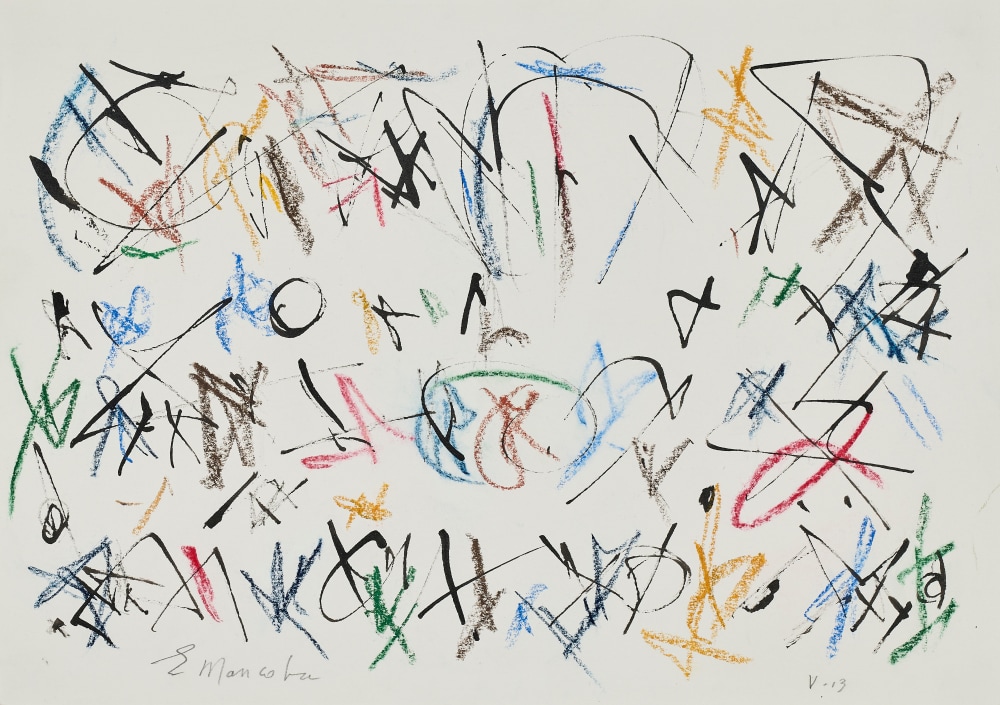
Ernest Mancoba
Untitled (V-13), 1990
Ink and Oil pastel on Paper
29.5 x 41.5 cm / 11.6 x 16.3in.
Ernest Mancoba was born just outside Johannesburg in the East Rand in 1904. He attended Grace Dieu, an Anglican missionary school where he developed his talents in sculpture. He furthered his studies at Fort Hare University but dropped out to become a full-time artist. He moved to Paris in 1938 to further his art studies, and married the Danish sculptor Sonja Ferlov while interning during the war. Mancoba preferred watercolour and only did his first oil painting in 1940. In 1947 Mancoba moved to Denmark; through Bille and Asger Jorn and met CoBrA artists. In 1952 he stopped producing sculptures and turned toward abstraction painting. With this shift he sought to attempt to integrate his knowledge of African cultures with modern European art.
In 1961 he became a French citizen and in 1994 re-visited his birth country for the first time since his departure on the occasion of a retrospective titled Hand in Hand, of his work and that of his wife, held at the Johannesburg Art Gallery and the South African National Gallery in Cape Town.
“[M]y own expression can have different interpretations, but one of the ways to see the figure of the paintings or drawings could also be as a spirit evoked, that … would represent or stand up for its endangered identity, in a hostile environment, and proclaim, paradoxically, the force of its fragile essence, amidst the chaotic affirmation of pure matter …” (‘An interview with Hans Ulrich Obrist’, Nka journal of contemporary African art, Spring/Summer 2003, page 19).
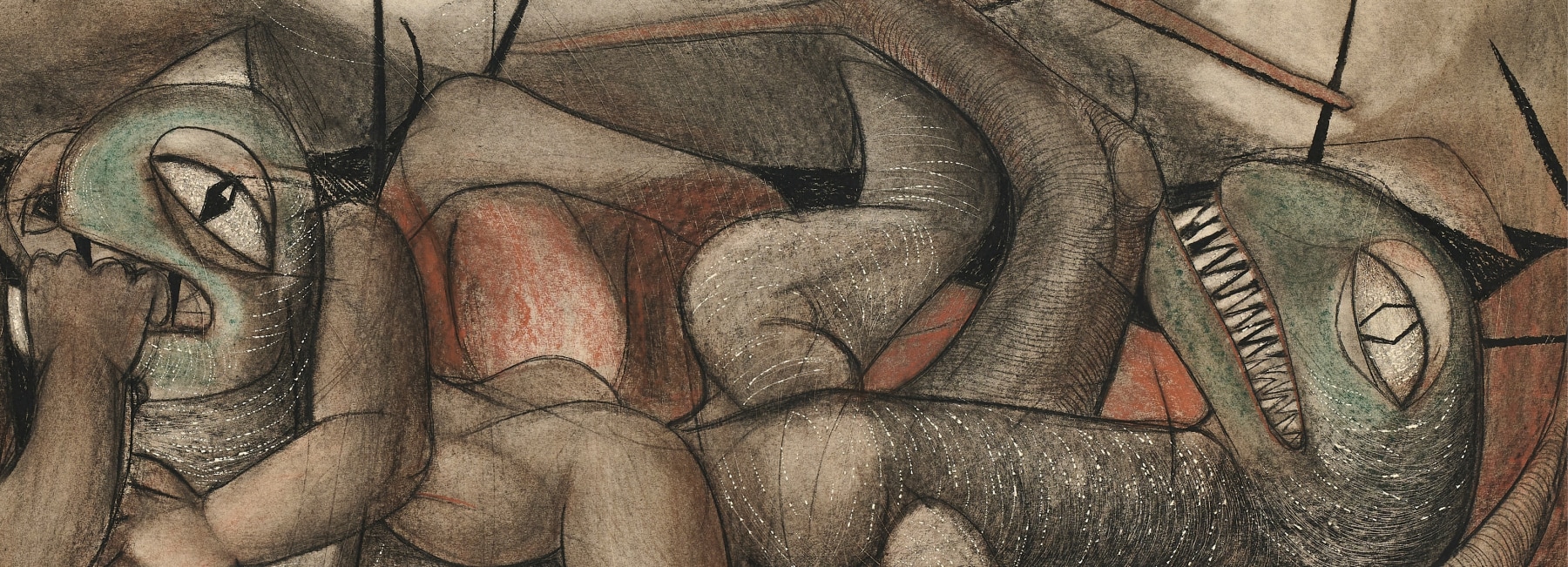
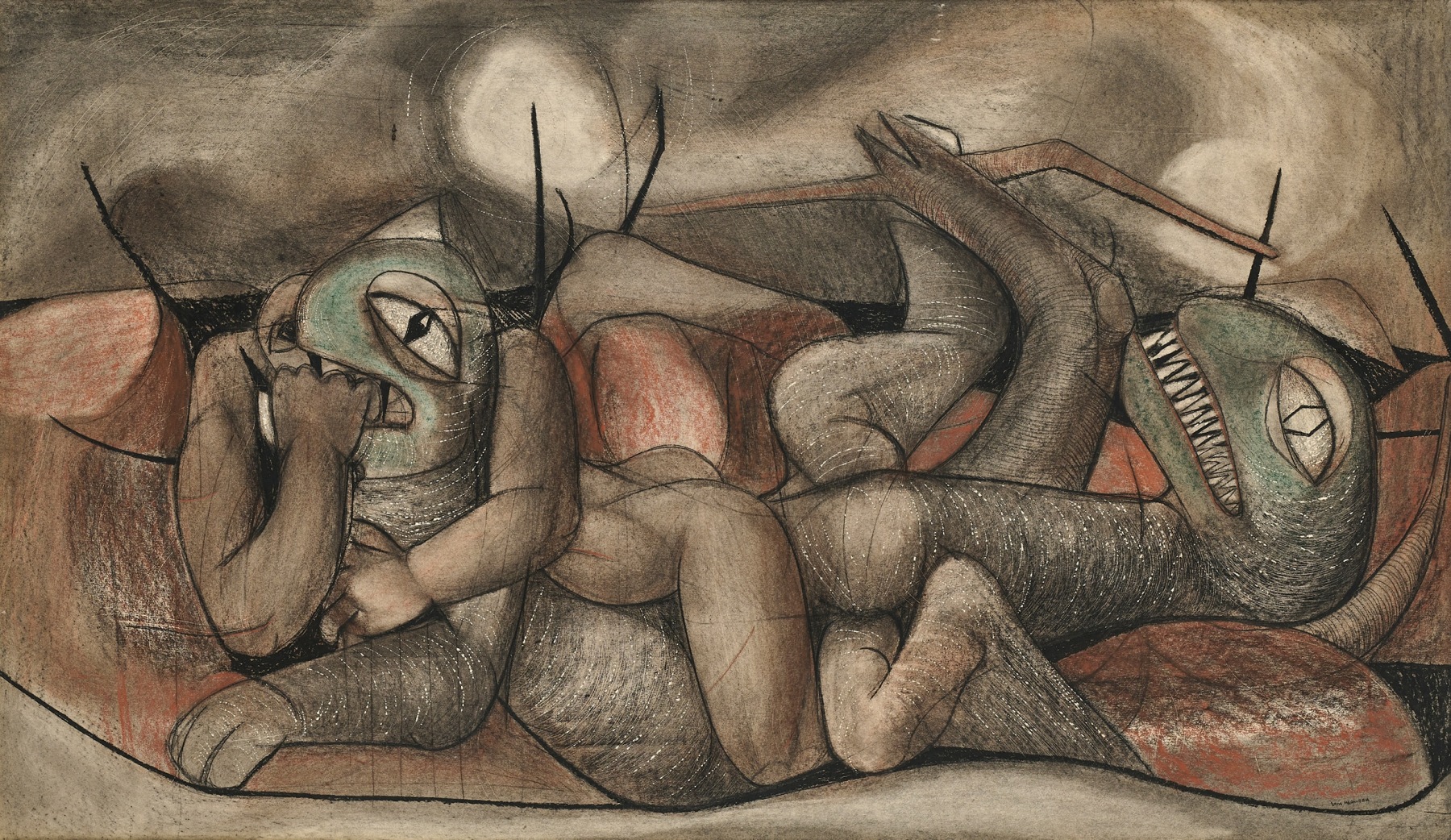
Louis Maqhubela
St. George and the Dragon, 1965
Charcoal and pastel on paper
120 x 69.5 cm / 47.2 x 27.4 in.
Louis Maqhubela arrived at a style of voluminous abstracted figuration in the mid-1960s after his studies at the Polly Street Art Centre, predominantly influenced by Sydney Kumalo’s sculpture, The Dancer (1965). This style pivots around Maqhubela’s earlier realistic depiction in the 1950s of Soweto township scenes, and the later pure abstract canvases of the 1970s and 80s. The use of the age-old subject matter, Saint George and the Dragon, could be ascribed to Maqhubela’s exposure to Kumalo’s early murals and sculptures for such churches in and around Johannesburg as St Peter Claver and St Martin de Porres. Religious themes often served as metaphors for early Black modernist artists, useful to depict the plight of the oppressed in apartheid South Africa, and in this case, a victory over the oppressor. Apart from benefiting from Kumalo’s teachings at Polly Street, Maqhubela was an avid reader of the numerous international art magazines available at the Centre, and he had an extensive art library of his own, including books on Paul Klee, Fernand Léger and Amedeo Modigliani. Their stylistic impact on the graphic quality of Maqhubela’s art at the time is evident. There is, however, a deep-seated African-ness evident in Maqhubela’s St George artwork: it is a veritable liberation theology visualisation of a slain apartheid dragon.
Louis Khehla Maqhubela (1939 – 2021) joined Durant Sihlali and David Koloane in the Soweto Group of weekend artists portraying local township scenes while he was still a pupil at Orlando High School. He attended the Polly Street Art Centre in 1958, studying under Cecil Skotnes and Sydney Kumalo. During the 1960s Maqhubela was employed as a plasterer by the Head of the Housing Section of the Johannesburg municipality’s Non-European Affairs Department, decorating numerous schools in Soweto. In 1966 he won the annual Adler Fielding Gallery award for “Artists of Fame and Promise” with a work entitled Peter’s Denial (similar in style to Saint George and the Dragon), which enabled him to travel to Europe and the United Kingdom. There he met Douglas Portway, who showed him the possibilities of pure abstraction, a style he adopted in his later work. Maqhubela and his family elected to leave South Africa, moving first to Spain in 1973, later settling in London, in 1978. where he studied at Goldsmith’s and the Slade School.
Text by Wilhelm van Rensburg, Senior Art Specialist and Head Curator at Strauss & Co.
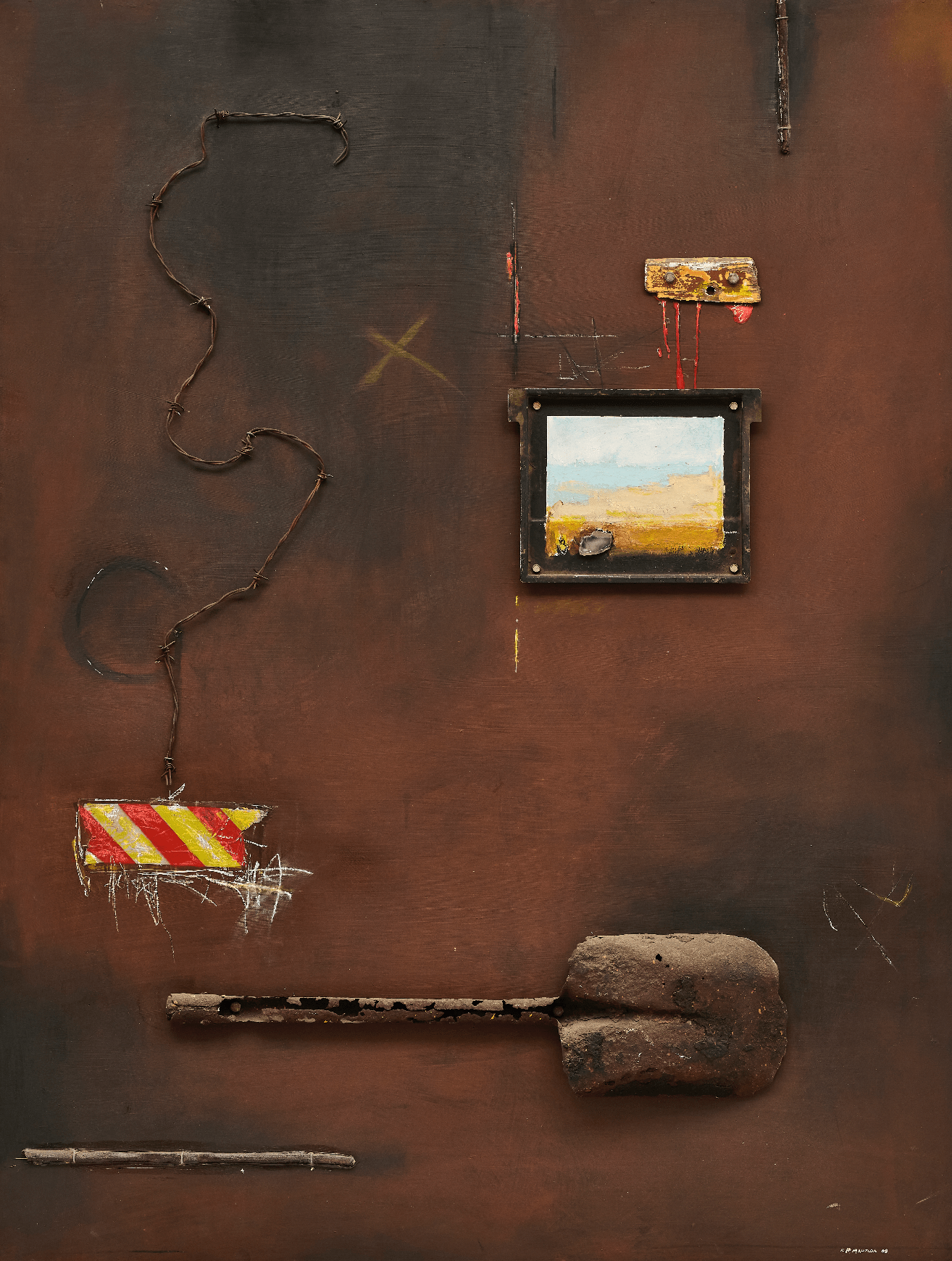
Kagiso Pat Mautloa
Treasure Hunt (08), 2008
Mixed media - oil painting, shovel, CorTen steel, plywood and found objects
160 x 122 cm / 63 x 48 in.
Treasure Hunt is typical of the works which established Mautloa in adapting the concepts of modern movements into a South African style with local resources and subjects. The urban culture of rapidly changing city street life, and social issues of tough township living are central to his multimedia practice.
Mautloa has long preferred to integrate formal work into abstract and expressionist collages and assemblages. Treasure Hunt features a painting in oils, sculptural elements and discarded objects, mounted into and onto his large panel of Corten steel. It is one in an ongoing series which refers to the gold mining history of Johannesburg. Barbed wire and chevron signage speak to the restriction of movement for Black labourers, the skin of rust on CorTen familiar to those workers living in metal shacks outside towns where no other work other than mining was an option. The painting provides a window of hope for a better future.
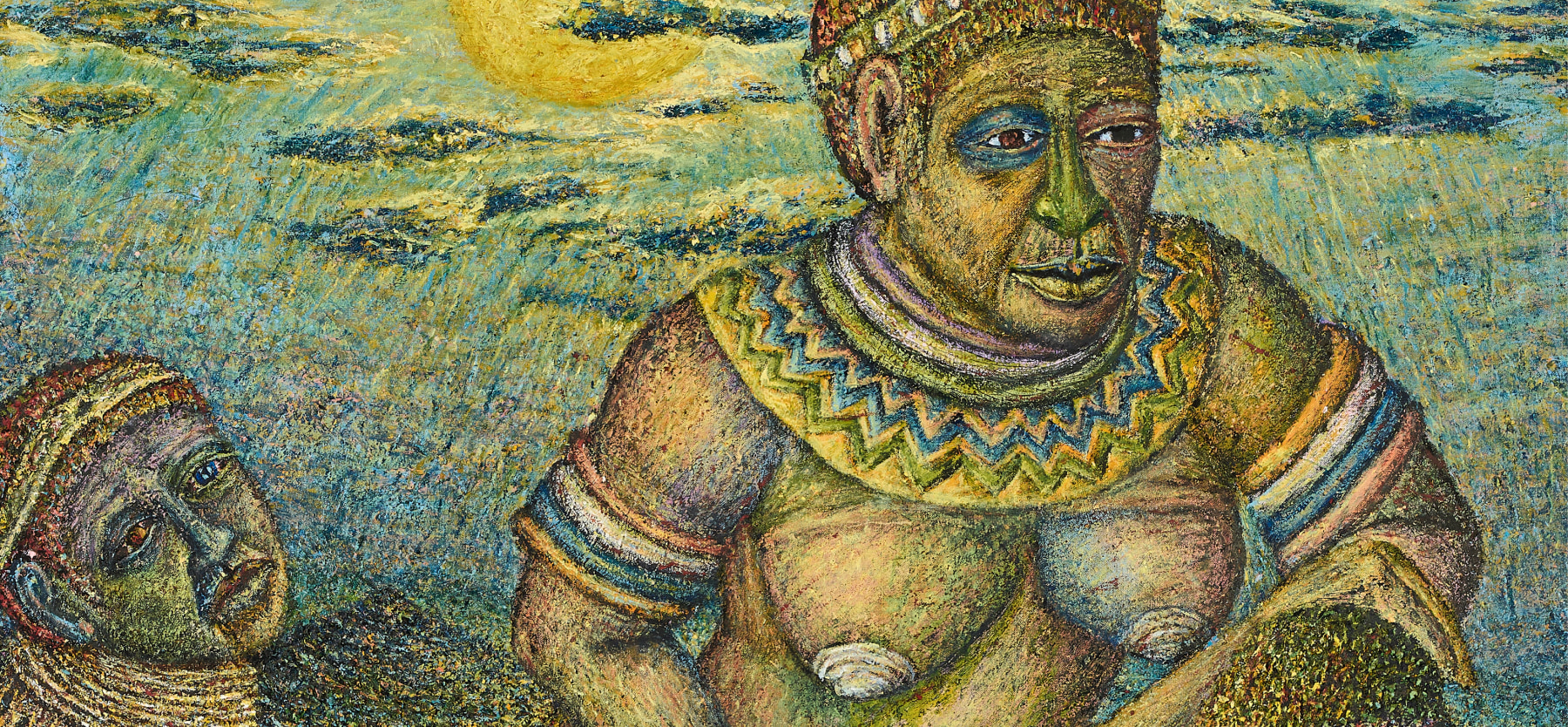
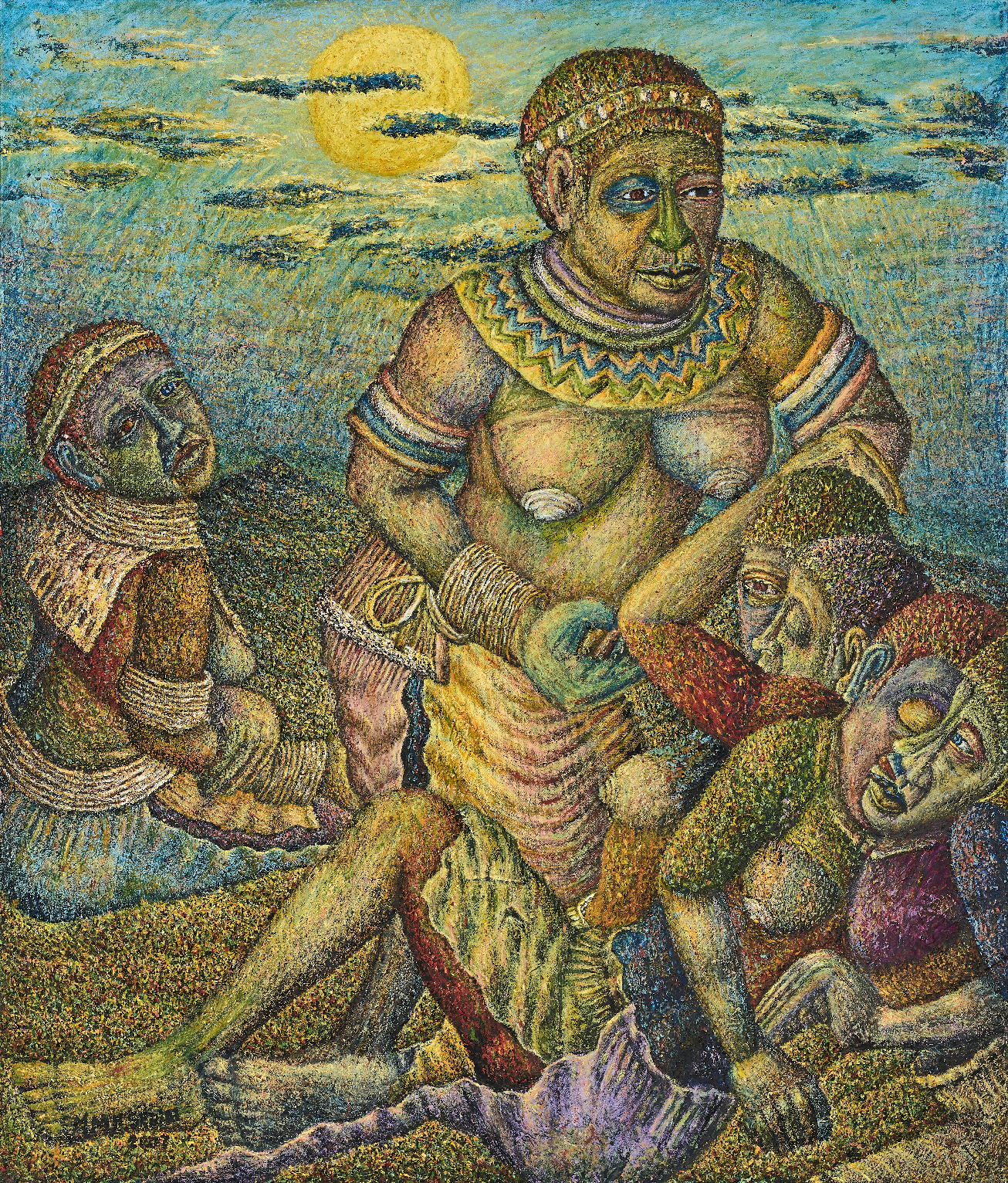
Helen Mmakgabo Mmapula Sebidi
Lost Human Life, 2007
Oil on canvas
110 x 94 cm / 43.3 x 37 in.
Sebidi’s earlier works reflect her focus on the South African landscape, and its spiritual significance to South African people. These works depict rural dwellings, women tending to fields or grinding corn and children tending to livestock. Sebidi develops a painting style that is quite unique; she applies layers of brightly coloured oil paint to create a grainy texture on the surface of the painting and balances the interplay of colour as a pointillist master would.
Her later compositions become more focused on the human figure, with surreal, mask-like faces and limbs and bodies that multiply. Sebidi warns of the effects of embracing a colonial, urban life on the spiritual integrity of indigenous South African peoples. Spirit guides often feature in her work, reminders of traditions and familial legacies that are at odds with Western modernity. Lost Human Life (2007) is a great example of her painting. The central figure is clad in traditional dress, as is the figure seated behind her, they are both painted with one blue eye and one red eye. Their differing eye colours indicate her ability to see into the spirit realm. The central figure offers a hand to the fallen figures below, to perhaps lead them back toward the traditional ways from which they have strayed.
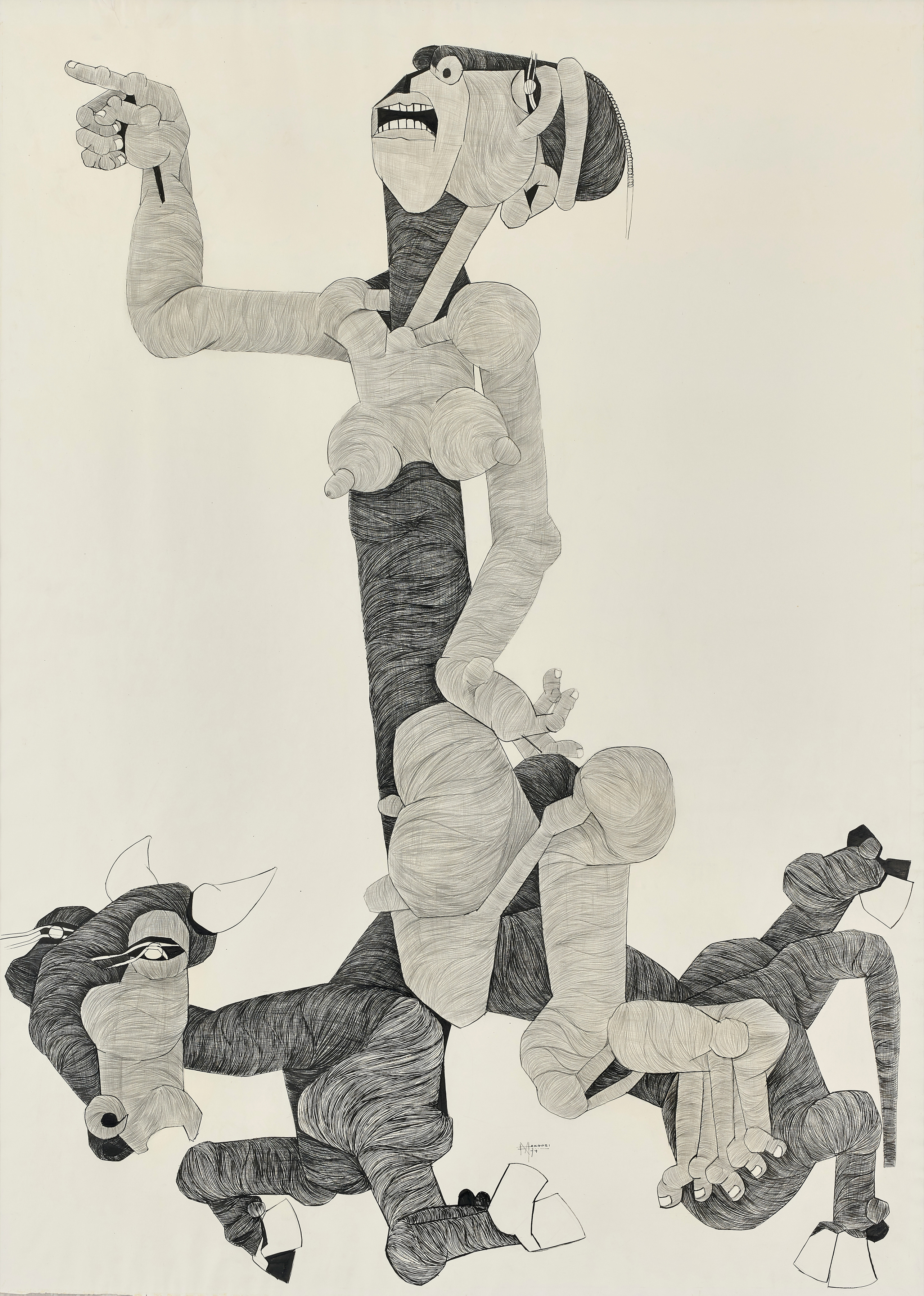
Nat Mokgosi
Mythological Rider, 1974
Pen, ink and charcoal on paper
150 x 100 cm / 59.1 x 39.4 in.
The depiction of man and beast as seen in Mythological Rider is a subject Mokgosi shared with many of his contemporaries, including artists such as Ezrom Legae, Sydney Kumalo (1935-1988) and Dumile Feni (1942-1991). This notable work reflects an era when many of the drawings Mokgosi produced were steeped in African spiritual mysticism. Created in 1974 when Mokgosi was producing some of his most significant works, Mythological Rider is impressive in scale, technique and visual concept. Exploring the motif of combining man and beast into a singular form, a feature common in Mokgosi’s work, Mythological Rider depicts a large human figure astride a stalking beast - likely a bull. The power relations are apparent as the figure is disproportionately larger than the comparatively small bull - a representation of power and submission and a perceptible commentary on the social and economic injustices of the 1970s.
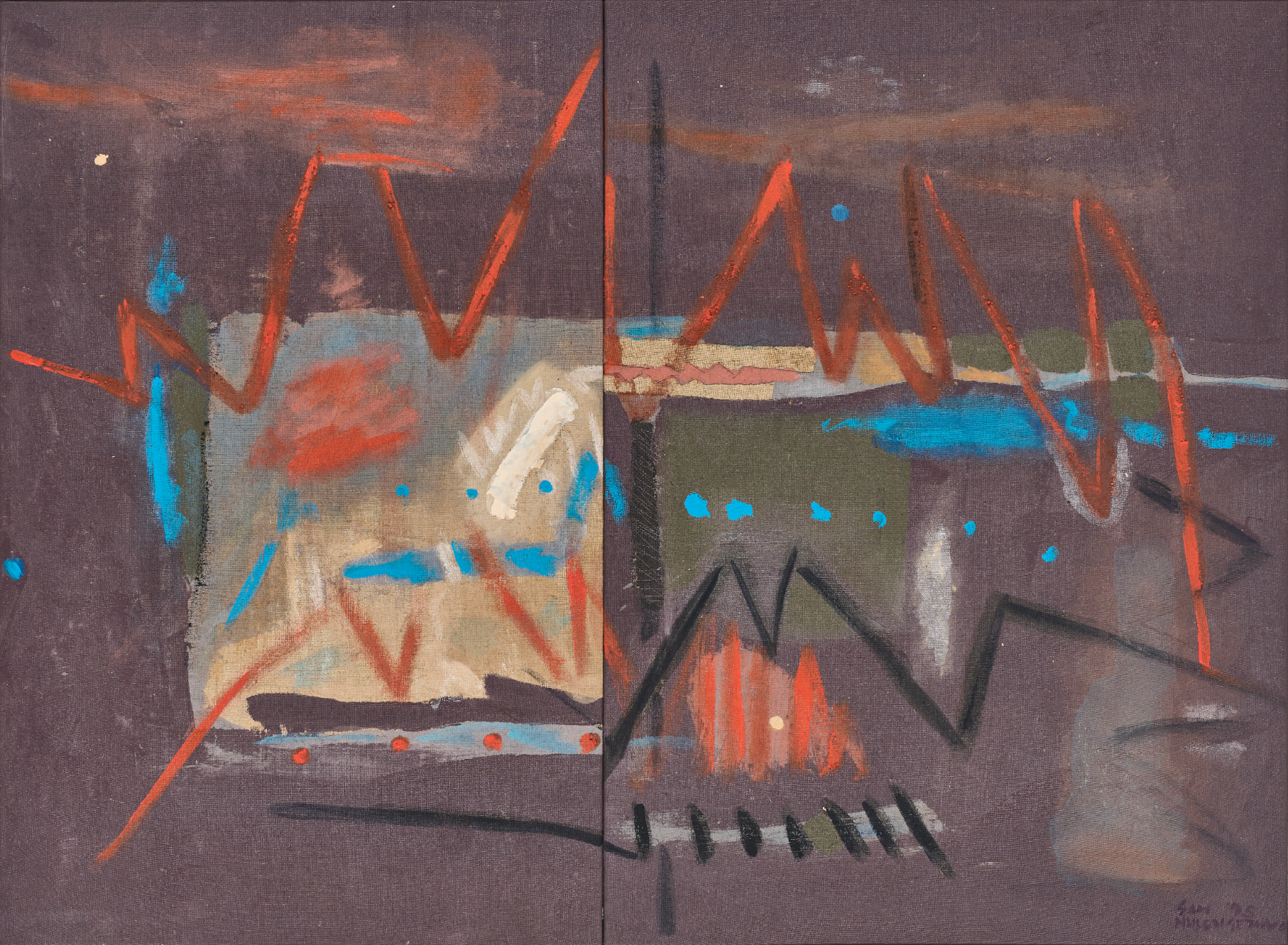
Sam Nhlengethwa
Senegal III, 1995
Oil on canvas
90 x 123 cm / 35.4 x 48.4 in.
Senegal lll (1995) is part of a series of abstract works produced during the AFRICA 95 workshop in Saint-Louis, Senegal. From South Africa, Nhlengethwa was selected to attend the workshop alongside David Koloane. This was the first workshop he attended on the African continent outside of his own country.
The work was influenced by the surroundings in Saint-Louis and the natural colours used by fellow artists. Painting the Senegal series was also a moment which saw Nhlengethwa revisiting abstraction, a mode of expression he was exposed to at the Thupelo Workshops; a series of workshops for black artists initiated in 1985 by David Koloane and Bill Ainslie. Senegal lll was part of Nhlengethwa’s private collection. This show, therefore, presents its debut in London as well as within an exhibition context.
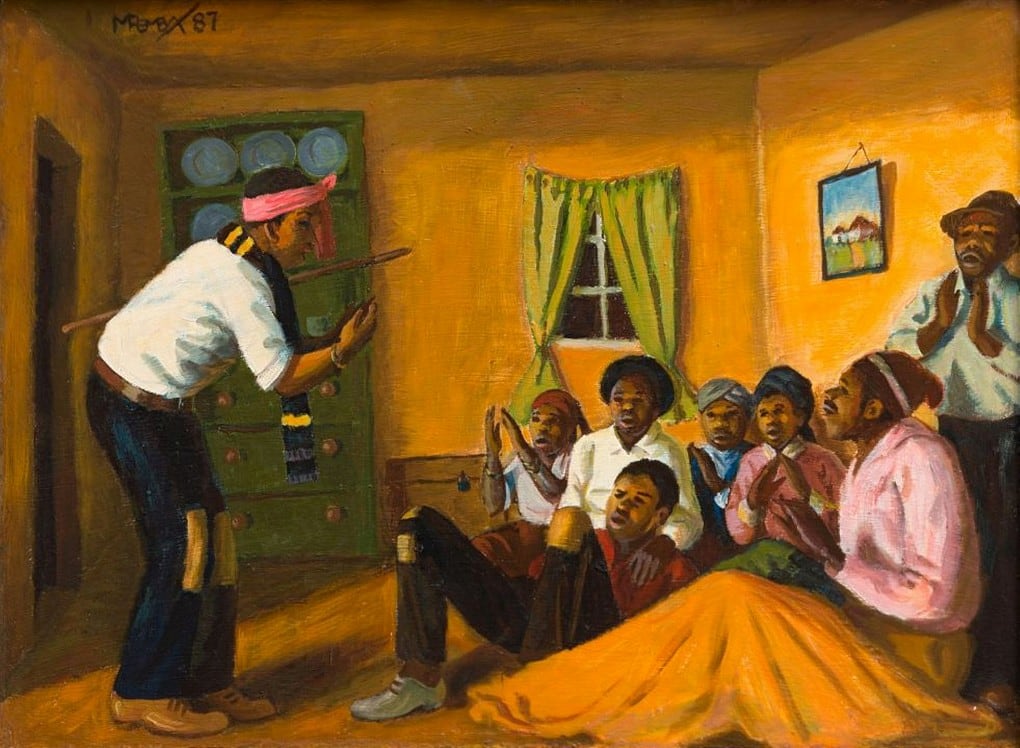
George Pemba
The Rehearsal: Umbhorho, 1987
Oil on board
38.5 x 53 cm / 15.2 x 20.9 in.
George Pemba was born in Korsten Village, Port Elizabeth in the Eastern Cape province of South Africa. This region of South Africa saw the influx of British settlers in the 1820s, who sought to expand the English territory and suppress its Xhosa people. Pemba received a Christian education through missionary-run schools, and his father was an elder in the Presbyterian Church.
Pemba chose to live in the Eastern Cape throughout his life, travelling to Cape Town once in the 1930s and then embarking on a nationwide tour of the country and its people in the mid-1940s. He then returned to the Eastern Cape and remained there, electing both to stay in South Africa, when his contemporaries were moving abroad to live in exile, and to live outside of the capital cities and hotbeds of political upheaval.
Pemba’s artistic talent was evident from a young age, and he initially focused on the medium of watercolour. He was inspired by the French Impressionist’s skilful manipulations of vibrant colour and the immediacy of technique. His aptitude for the medium was recognised and, although he was not able to study fine art at a tertiary level due to his race, he did receive two weeks of intensive instruction in watercolour painting with and Ethyl Smith, a teacher at the University of Fort Hare, and later he studied for four months at the Rhodes University Art School under the tutelage of Winter Moore in 1936.
In 1937, the first exhibition for Black South Africans was held at Fort Hare and Pemba’s work received great acclaim, as did the work of Gerard Sekoto. It was during a trip to Cape Town in 1942 when Pemba and Sekoto discussed the merits of oil paint, and after Pemba’s trip through South Africa in 1944 he turned his attention to the medium. His subject matter reflected his interest in indigenous cultures and traditions, which had been largely suppressed by colonial rule in favour of a more “civilised”, Christian way of life. This conflict between his religious upbringing and his Xhosa heritage is alluded to in many works by the artist. The Rehearsal: Umbhorho (1987) depicts a man with a spear, animatedly addressing a group of people in a living room. A painting of a rural landscape hangs on the wall, linking the conversation in the humble interior with a rural idyll.
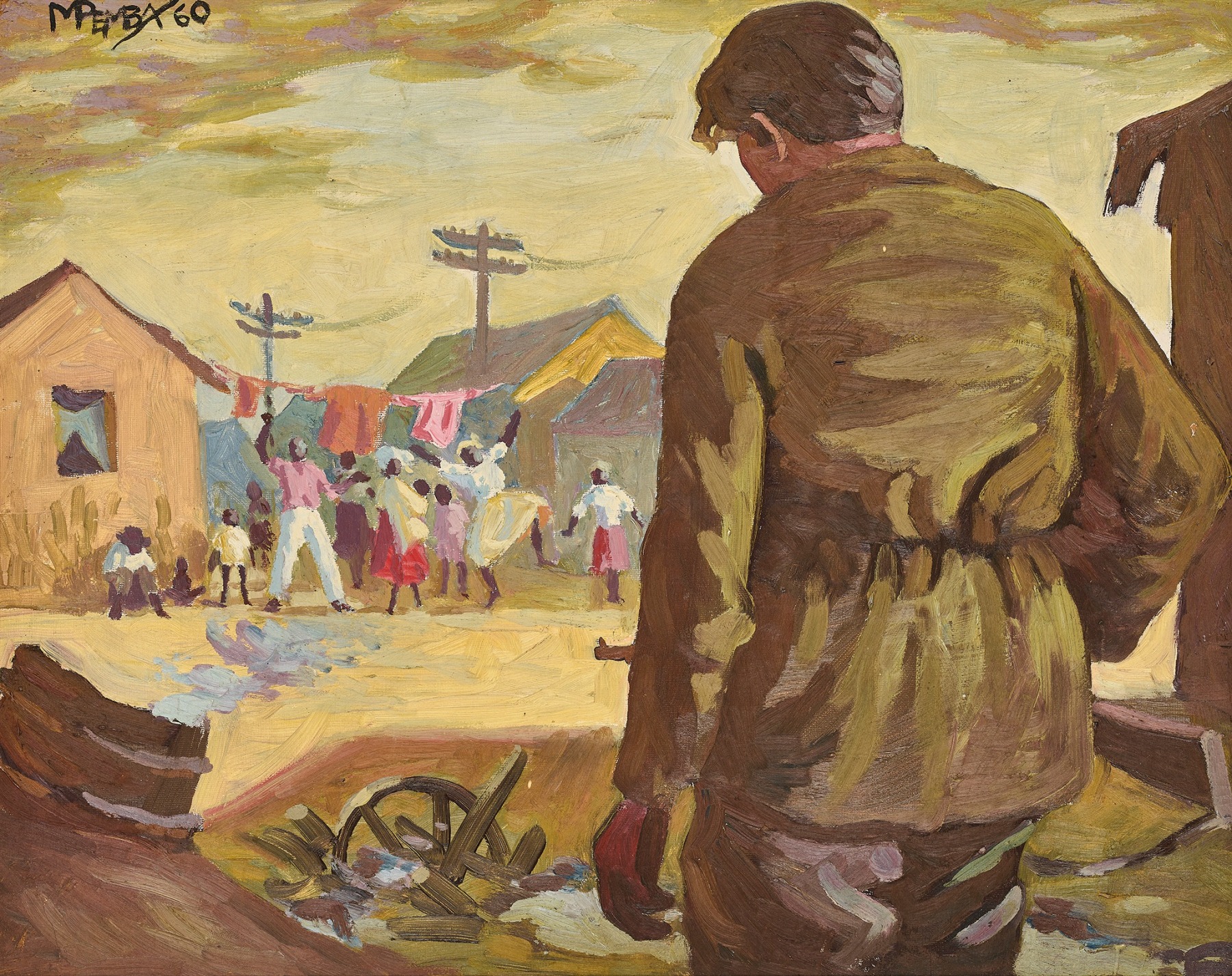
George Pemba
Clean up, 1960
Oil on board
40 x 50 cm / 15.7 x 19.7 in.
In 1945, Pemba joined the ANC and became an active member of the party in the Eastern Cape. The 1950s and 1960s were decades marred by violence as the apartheid government brutally suppressed mass uprisings, culminating in the Sharpeville massacre in 1960 and the June 16th 1976 uprising in Soweto. The police force and military unleashed terrible violence upon unarmed black protestors and the ripples of horror and outrage reverberated throughout the townships of the country.
Pemba’s subject matter shifted to reflect the political conflict, Clean Up (1960) is an iconic example of Pemba’s addressing the looming brutality of the police force, closely monitoring the townships for the slightest signs of resistance.
The two paintings by Pemba featured on this exhibition are wonderful examples of the artist’s use of French Impressionist style, to communicate the realities of black South Africans grappling with the war of colonial and Christian morality against centuries-old indigenous culture, as well as the horrors of the violent suppression of human rights. Pemba’s depictions of the townships of Korsten and New Brighton, are an important deviation from the Impressionists depictions of idyllic landscapes and gentrified society. Instead, we see snapshots of segregated communities in times of deep political tension.
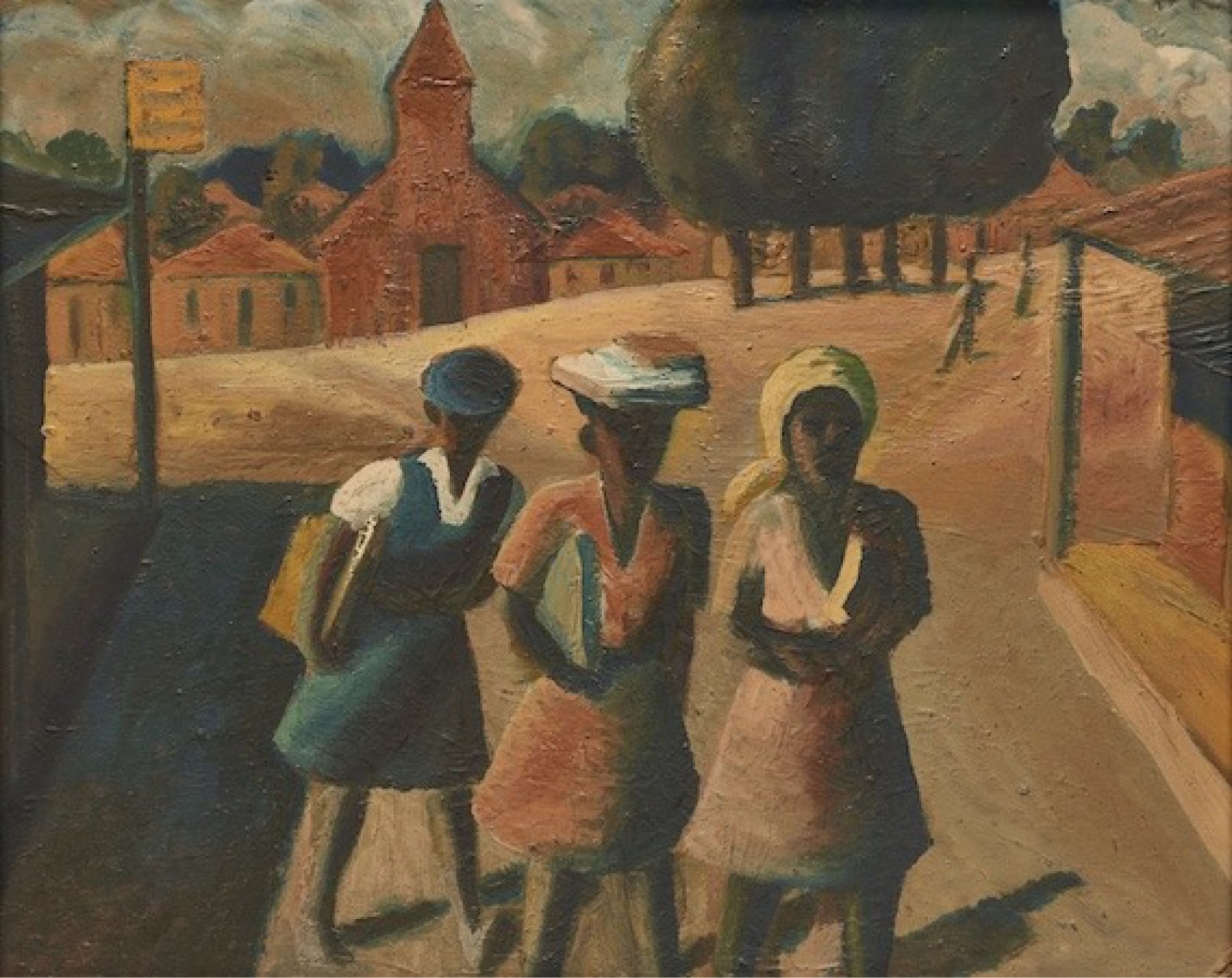
Gerard Sekoto
Three School Girls, 1946/1947
Oil on board
40.5 x 50.5 cm / 15.9 x 19.9 in.
Three School Girls is an important example of the work produced during Sekoto’s short stint in Eastwood when he painted scenes from everyday urban life with great poignancy. Sensitively rendered, it demonstrates Sekoto’s skill in empathetically capturing the lives and experiences of his community. This painting was first exhibited and sold at his highly successful exhibition at Gainsborough Galleries in Johannesburg in 1947, two months before his departure to Paris – the exhibition was critical in raising money for his journey and relocation process. Three School Girls reveals the deep understanding, warmth and empathy with which Sekoto depicted his fellow people of colour and the communities in which he lived, while at the same time offering a unique glimpse into their ordinary daily lives.
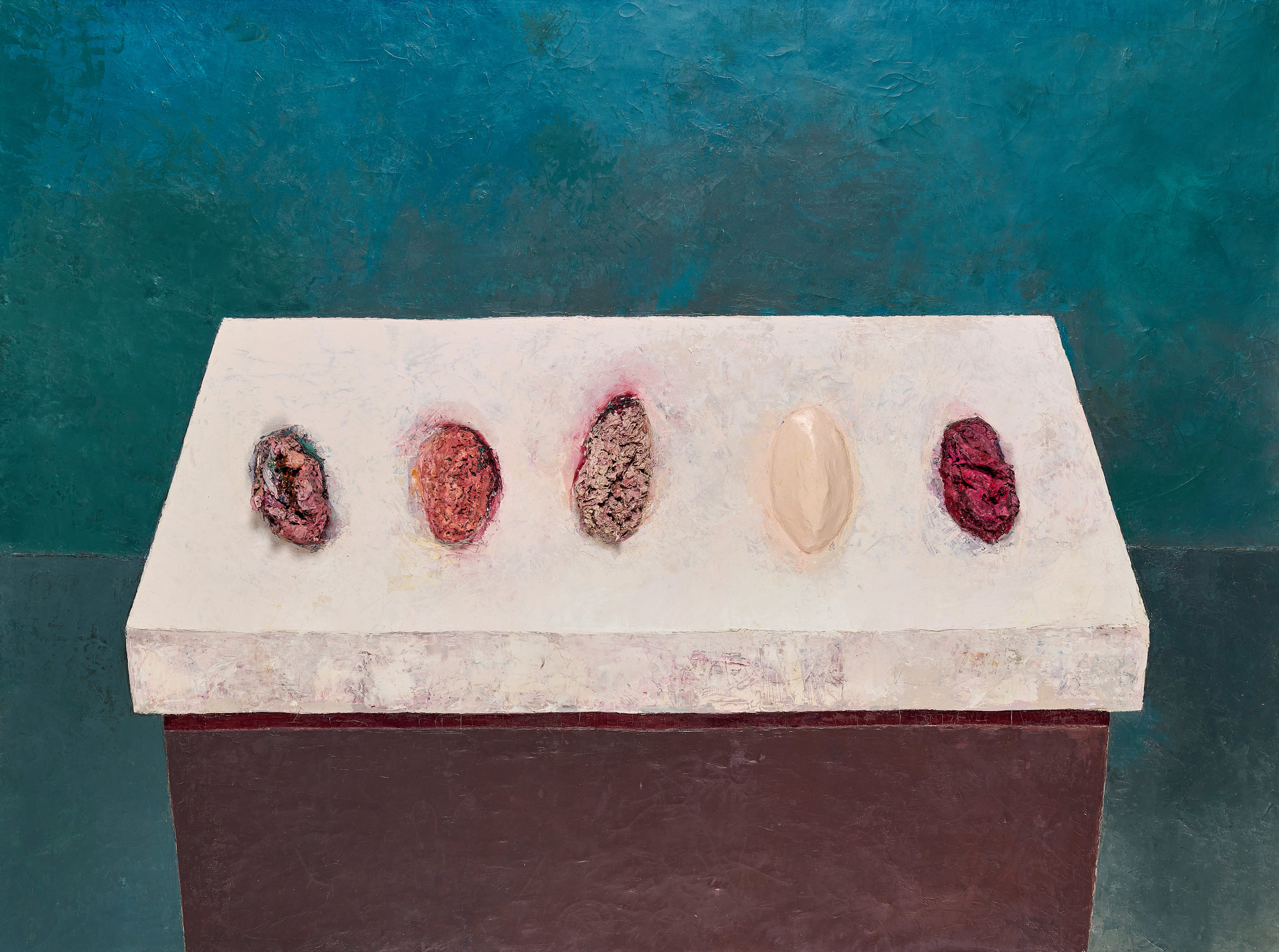
Penny Siopis
Slab, 1982
Oil on canvas mounted to board
92 x 121.5 / 36.2 x 47.8 in.
In her diverse practice, Penny Siopis explores the intersection of personal and public histories in South Africa. In the 1980s, Siopis produced history paintings that addressed race and gender representation in public narratives. All of Siopis’ explorations, whether with body politics, memory, migration, or the relations between the human and non-human, are characterised by her interest in what she calls the ‘poetics of vulnerability’ – embodied in the dynamic play between materiality and reference, chance and contingency, form and formlessness, personal and collective history. Paint in Siopis’ hands is a medium of sensuous and conceptual alterity, of strangeness, of otherness. The touch-oriented, sensuous intimacy of her early work, the logic of assembling readymade materials in complex spatial constellations in the history paintings and assemblages, which follow through in her later installations, can be traced to her use of paint as object, sign, and surface from her earliest creative years. Siopis’ creative affair with materiality and surface is as much an intellectual as an intuitive passion.
Siopis sees the skin as where public and private meet. Skin is a zone of magical contamination, where metonymy and metaphor, contiguity and arbitrary signification clash and play out on a shifting, semiotic sediment of what goes before and beneath. An elemental fragility typifies skin, a vulnerability to internal or external violation, to overwhelming physical sensation. Not only is skin the largest single organ of the body, but is also its primary surface. It clothes our flesh and is the outside containing our inside. It protects and it marks us. It even stigmatises us. Siopis noted that when oil paint is built up into relief it “evokes associations with human skin and flesh, changing as it does in time, aging, wrinkling and cracking as it loses its juices”.
Siopis is a Master’s in Fine Arts graduate of Rhodes University, Makhanda, South Africa and holds an Honorary Doctorate from her Alma Mater. She has studied further and taught widely, in South Africa, the UK and Sweden, and is now an Honorary Professor at the University of Cape Town. She is widely regarded as one of the country’s most influential artists and academics. Her work is held in many public collections and museums in SA, UK, the USA and Europe.
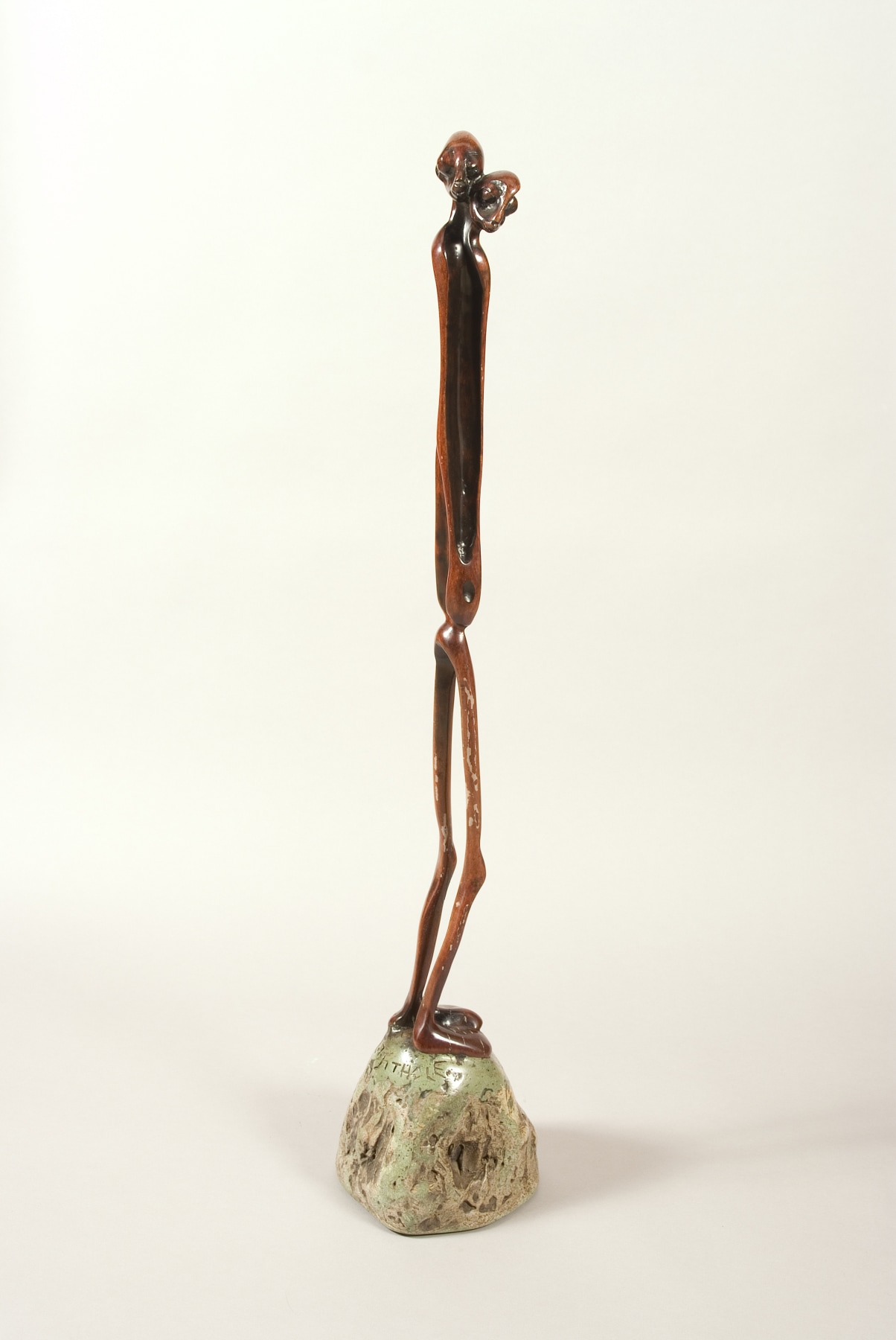
Lucas Sithole
Winter II, 1975
Rhodesian teak on Liquid steel Base
110 cm / 43.3 in.
Gathering knotted tree roots and tuberculated branches from dry riverbeds in early winter, enabled Lucas Sithole to sculpt his unique figures and animals, the shapes emerging organically from these pieces of wood, he always claimed. Roots often resulted in strange creatures or squat, seated figures, and branches in stretched-out, elongated figures, such as Winter II. These attenuated figures seem to defy gravity, to reach heavenwards, but they also have ritualistic traditional African meanings. What is especially noteworthy of Winter II, is the double-headed figure with spindly legs and emaciated torso: the second head signaling an alter ego, or a guardian spirit, or perhaps symbolizing the notion of opposites, such as male/female, or good/evil. The liquid steel base, in the shape of a bell, implies an inaudible sound, like the implied but inaudible sounds emanating from the open mouths of the two heads. In a tree, in broken trunks and snapped branches, Sithole sees analogies with life and with humanity. “A tree”, he says, “is like a human with veins. The branches represent the veins”. In sculpting a figure from such a branch, he restores life to the dead tree.
Text by Wilhelm van Rensburg, Senior Art Specialist and Head Curator at Strauss & Co.
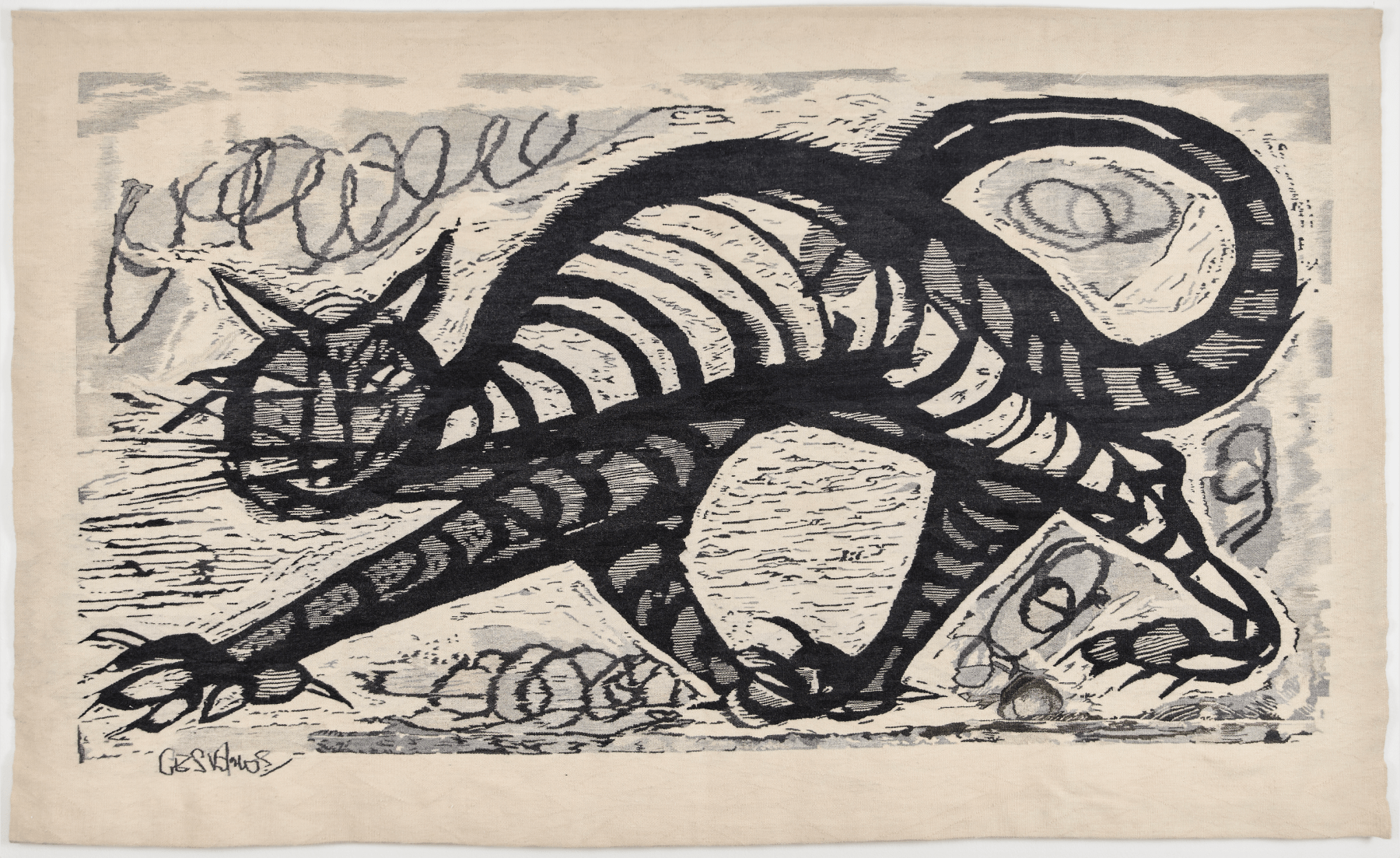
Cecil Skotnes and Marguerite Stephens
The One-Eyed cat, 1963/2020
Woven mohair
178 x 298 cm / 70.1 x 117.3 in.
Edition of 5
Cecil Skotnes was a South African artist, teacher and influential mentor. In 1952, Skotnes was appointed Cultural Relations Officer at the Polly Street Art Centre - on the border of two racially segregated suburbs in Johannesburg. Skotnes’ role was to encourage creativity and talent among young Black artists and artists of colour, who lacked opportunity and access to materials and skills development during apartheid. He sought to create an integrated environment along workshop lines where artists could exchange ideas and techniques as well as learn formal skills. He worked closely with notable colleagues including Sydney Kumalo, Lucas Sithole, Leonard Matsoso, Dumile Feni, Ezrom Legae, Durant Sihlali and briefly David Koloane. All went on to prominent careers.
Koloane chose to move away from the Western formal teaching favoured at Polly Street where the artists were advised to develop a “marketable style.” Koloane, highly respected, believed promoting the Western view worked to the detriment of genuine African style and free choice of subject. His departure influenced Skotnes and Kumalo to re-evaluate the curriculum.
Members of the Polly Street group, including Skotnes, moved away from Eurocentric practice. Durant Sihlali in an interview with Koloane, later recalled that Skotnes “went on to encourage expressive interpretation of observed objects. He and Kumalo began working from African sources … and their success had great influence on the practice of other students and colleagues.”
Skotnes shifted from painting to relief carving, woodblock printmaking, carved sculpture and using pure pigments in preference to oils. Producing prints, murals, installations, sculpture and pigment-coloured, incised panels and totems, Skotnes went on to represent South Africa at Venice and Sao Paulo Biennales.
He became acquainted with Marguerite Stephens in the 50’s and both later worked closely with Goodman Gallery. The weaver continues her practice to the present day. Skotnes’ tapestry The One-Eyed Cat is edition 1/5 by the Marguerite Stephens Tapestry Studio. Based on one of Skotnes’ best-known images - a woodcut print from 1960, it has been cited by William Kentridge as an inspiration for the cats featured in his animated films and large woodcut images.
Stephens is herself a legend in South African fine art circles. Her grand mural scale, Gobelin-style loom weavings in mohair have been made in collaboration with many and diverse artists for over sixty years. Stephens has worked in collaboration with Goodman Gallery artists including Walter Battiss, Sydney Kumalo, Sam Nhlengethwa, Penny Siopis and since the late 1990s, extensively with William Kentridge.

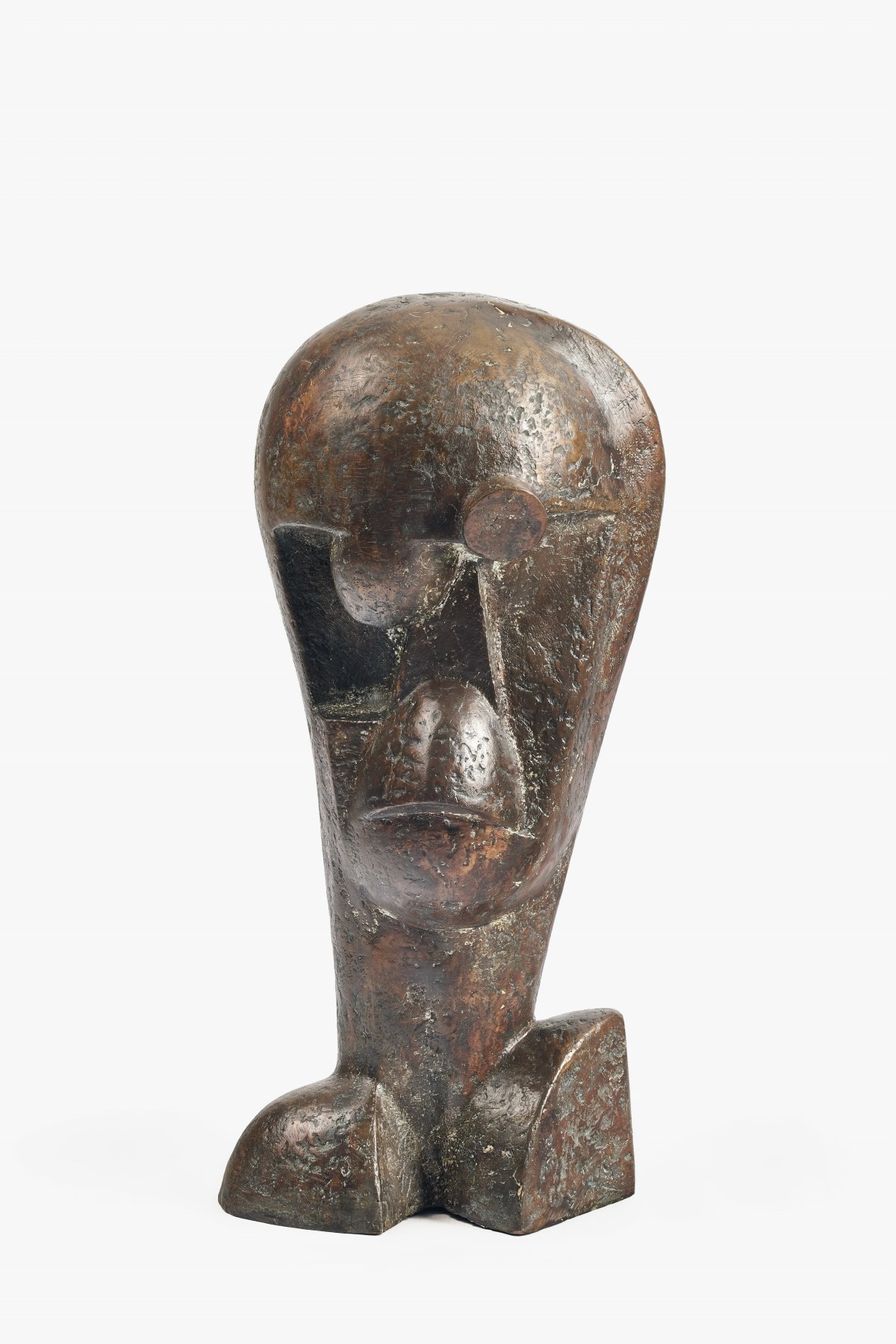
Edoardo Villa
African Mask I, 1964
Bronze
65 x 31 x 30.5 cm / 25.6 x 12.2 x 12 in.
In Edoardo Villa’s powerful, elongated sculpture of a head, with its prominent single eye, the volumetric surfaces contrast with complex, faceted forms, eschewing his naturalistic training in Italy in the 1930s. Displaced by World War ll, Villa became a prisoner-of-war in Egypt and was subsequently interned at Zonderwater in South Africa. At the end of the war, Villa elected to stay on, and forged a significant career as a sculptor that went on to span six, extremely productive decades. He was impelled by the new environment in which he found himself to engage with a very different topography, plant-life, socio-political context and a rich cultural history of African sculpture. In the home of the contemporary, German art dealer, Egon Guenther and his Italian compatriot, Vittorino Meneghelli, Villa was exposed to important examples of African masks, ancestral figures and staffs of office.
The influence of African sculpture on Villa’s work, and that of his fellow sculptors, Sydney Kumalo and Ezrom Legae, in the 1960s was profound. From a distance – in particular through the work of Gonzales, Picasso, Moore and David Smith, Villa also came to grips with the radical shifts in European art as it grappled with the liberating, alternative forms of representation of African, Oceanic and Mesoamerican sculpture.
Through his art, Villa explored a more stylised and inventive analysis of both human form and emotion, freeing his sculptural expression. His bronze heads, as in this case, represent – as in much African art – the interface between the complexities of personal identity and the presence of an ancestral inner world that links us all.
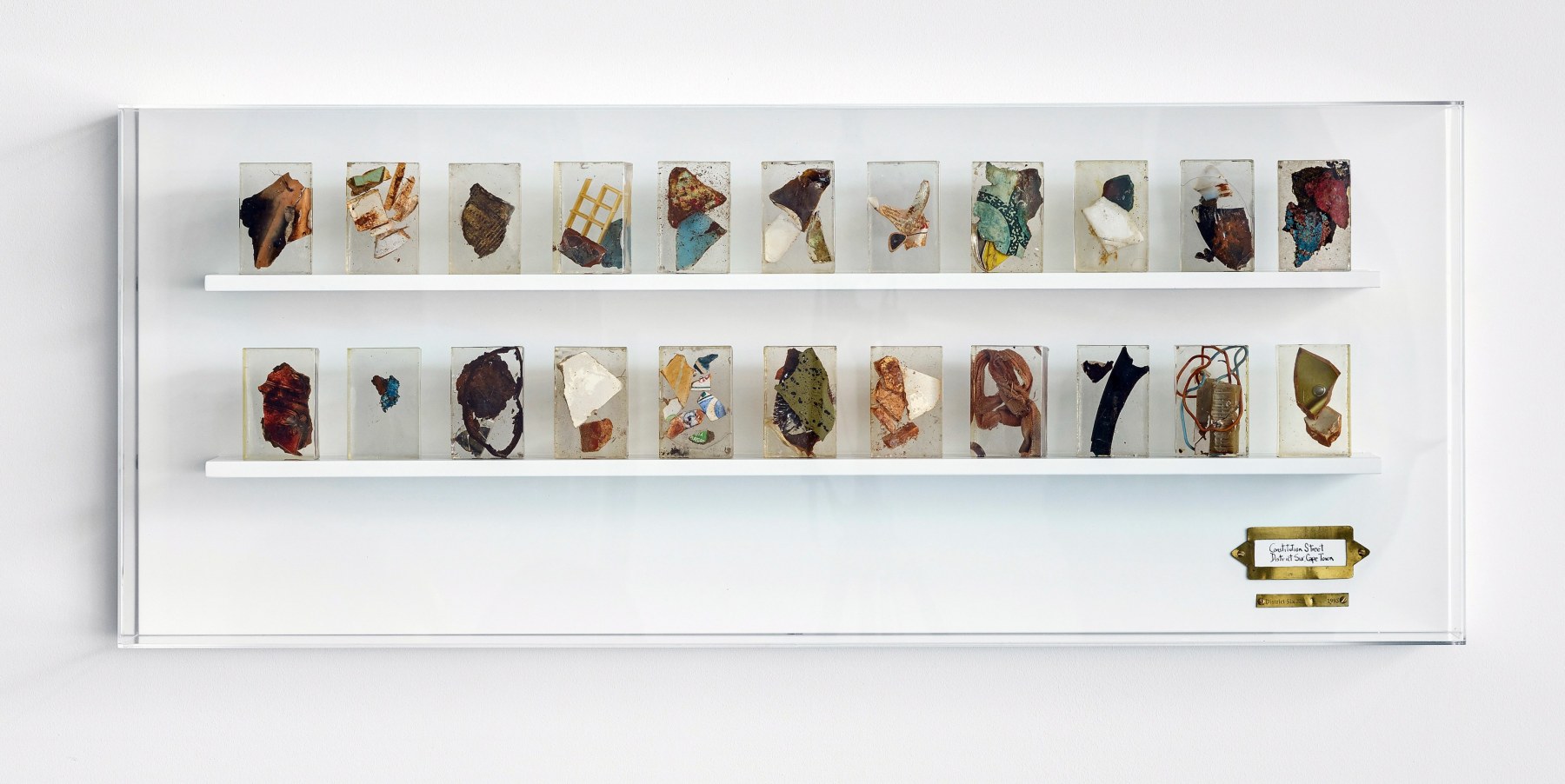
Sue Williamson
District Six: Museum Case # 9, Nile Street, 1993 and 2023, 2023
Found objects in casting and polyurethane resin in wood and perspex case.
42.9 x 103 x 12 cm / 16.9 x 40.6 x 4.7 in.
Sue Williamson (b. 1941) is an acclaimed multidisciplinary artist and an accomplished writer and critic in the field of fine arts. Her family emigrated to South Africa in 1948. Trained as a printmaker, her broader practice now encompasses photography, film, drawing, sculpture, print and Installation works. Since the 1970’s the artist has engaged with social issues both during and following the times of apartheid policies in South Africa and continues to deal with ongoing struggles for true equality in the country.
Well known series of works include A Few South Africans, produced in the 1980’s, which focuses on women involved in the political struggles; and varied iterations of Messages from the Atlantic Passage, a large-scale, variable installation of shackled, suspended glass bottles engraved with details taken from 19th century slave trade documents. This installation followed a work in similar materials concerning slavery in the Cape Colony, Messages from the Moat, which featured on the 1997 Johannesburg Biennale, curated by Okwui Enwezor.
Her works are held in many public collections around the world including those of the Museum of Modern Art, New York, Tate Modern, London, National Museum of African Art, Smithsonian Institution, Washington D.C., Pompidou Centre, Paris, Wifredo Lam Centre, Havana and Iziko South African National Gallery, Cape Town.
In Spring this year, Williamson had her first solo museum show in the UK with Between Memory and Forgetting at The Box Museum, Plymouth. One month later, her two person show with Lebohang Kganye, Tell Me What You Remember opened at the Barnes Foundation in Philadephia, and her solo show Other Voices, Other Cities opens at the Centro Atlantica de Arte Moderno in Las Palmas, Gran Canaria in October. In November, she will take up an artist residency at the Yale Center for British Art in New Haven.
District Six: Museum Case # 9, Nile Street comes from another renowned series of works by Sue Williamson, concerning the forced removals of families of colour from District Six, near to the city centre of Cape Town. The infamous demolition and physical manhandling of people protesting the loss of their homes and banishment to newly proclaimed areas some distance from the city was a landmark act of social violence in the enforcement of the segregation of races in apartheid ruled South Africa.
Williamson gathered fragments of various household objects that had remained in the area following demolitions during the 1970's and early 1980’s and cast these fragments in small resin blocks. Named for the streets she had seen bulldozed, groups of these fragments of destroyed homes have since then, over time been encased in plexiglass vitrine-like cases, such as in District Six Museum Case #9, Nile Street, 1993 and 2023.

